What your state looked like in the 1970s
Living in the Seventies
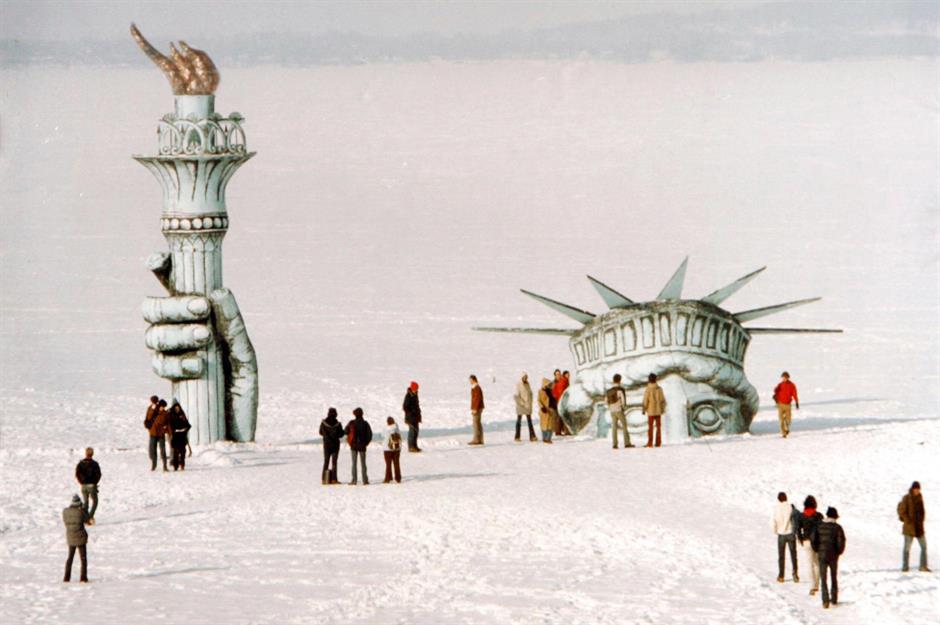
American novelist Tom Wolfe described the 1970s in the USA as the ‘Me Decade’. It was a time when Americans put the turbulent 1960s behind them and had some fun. It was an attitude reflected in colorful fashion, music, and in leisure pursuits.
Click through the gallery to see what your state looked like in the 1970s and just how much times have changed…
Alabama: Alabama Theatre, Birmingham (1972)
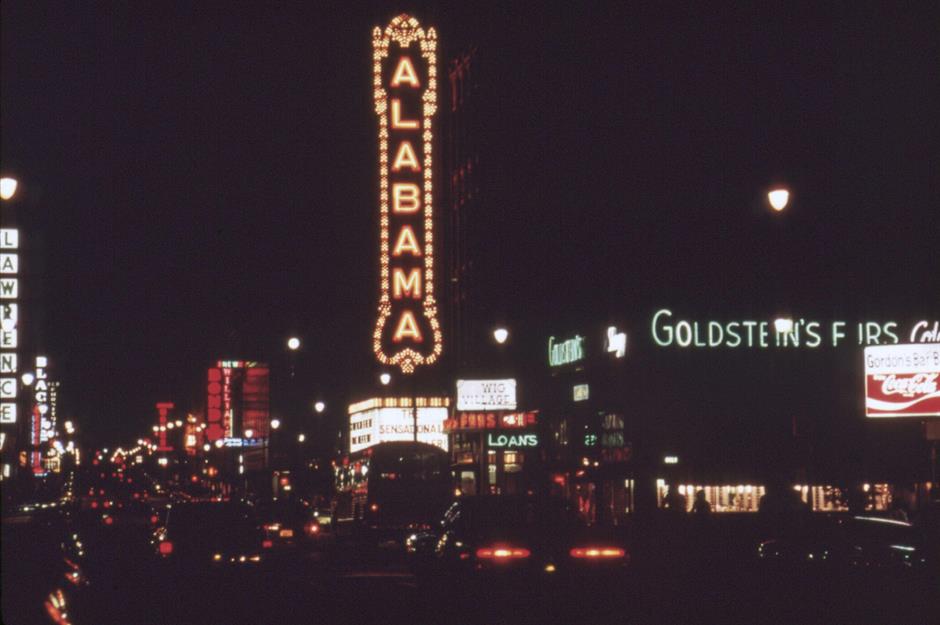
Welcome to 3rd Avenue North in downtown Birmingham on a busy Saturday night in 1972. The distinctive illuminated sign for the Alabama Theater catches the eye, then as it still does today.
The lavishly ornate Alabama theater opened in 1927 and quickly became known as the ‘Showplace of the South’, treating the residents of Birmingham to movies, concerts, beauty pageants, silent films, and even the Mickey Mouse Club.
Alaska: Fishing on Nonvianuk Lake (1973)
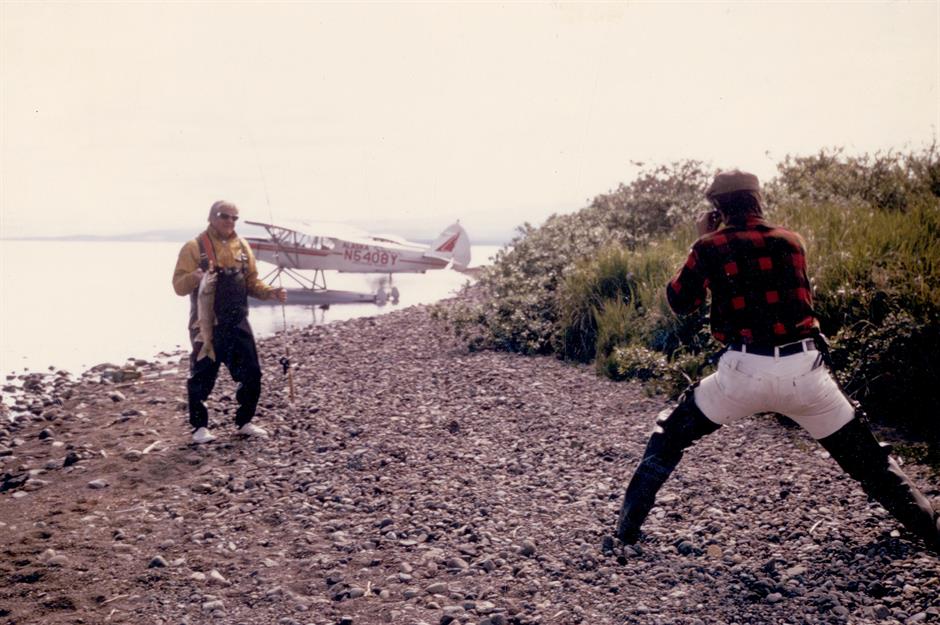
The call of the wild has always been strong in Alaska, particularly for keen fishermen. Here we see one such angler showing off his impressive catch on Nonvianuk Lake in the summer of 1973.
Sitting at the top of the Alaska (Aleutian) peninsula, 243 miles southwest of Anchorage, the lake continues to be something of a holy grail for anglers and, like in this photo, is still best reached by floatplane.
Arizona: Route 66, Winslow (1979)
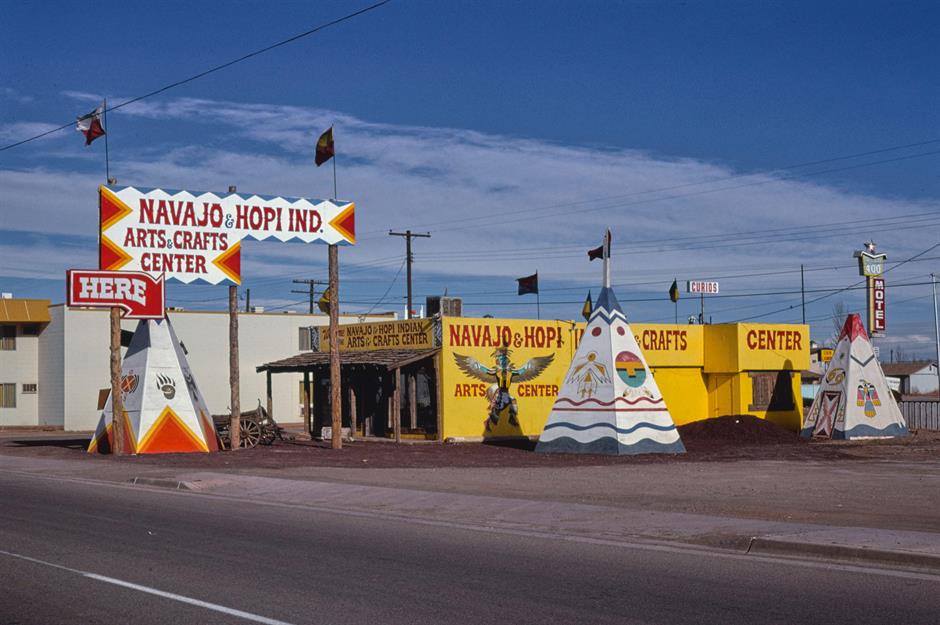
Here we see the Navajo and Hopi Arts & Crafts Center on Route 66 as it passes through Winslow in northern Arizona. The photo was taken in 1979, just as the world-famous route was replaced by Interstate 40, bypassing the town altogether.
The center leaned heavily into the Hollywood version of Native Americans most people still believed in back then. Travelers were lured into sheet metal tipis to buy postcards and souvenirs, even though the Navajos of the area typically lived in hogans – dome shaped log cabins covered in mud.
Arkansas: Testing for pollution in Fort Smith (1973)
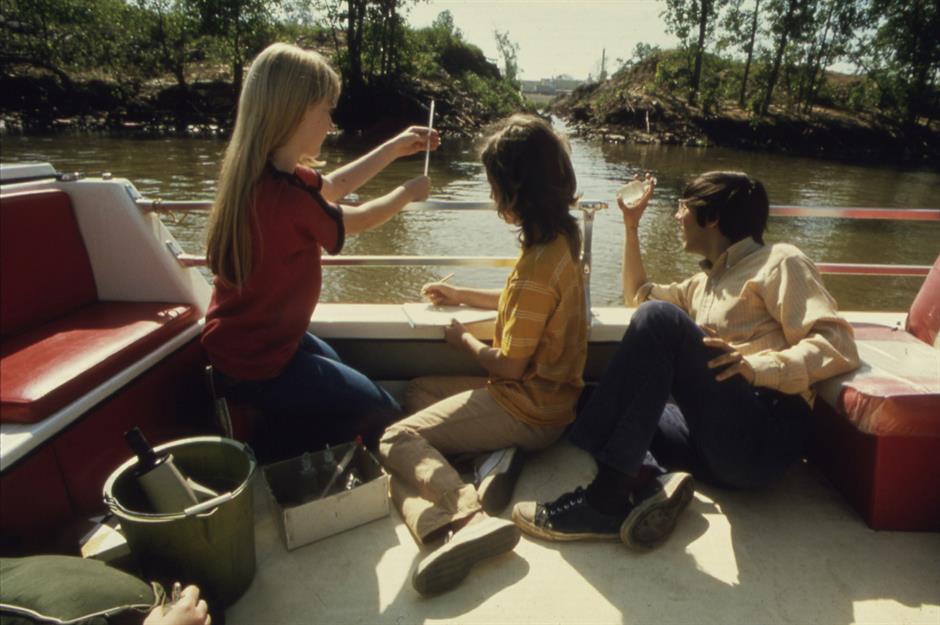
The 1970s saw an increase in awareness of environmental issues and in the power of the government body vested with monitoring them – the Environmental Protection Agency.
That included DOCUMERICA, a program to document subjects of environmental concern across the nation. The project covered both urban and natural areas, and included this group of school children, testing water in the Arkansas River for pollution in Fort Smith in 1973.
Love this? Follow our Facebook page for more travel inspiration
California: The streets of San Francisco (c.1970)
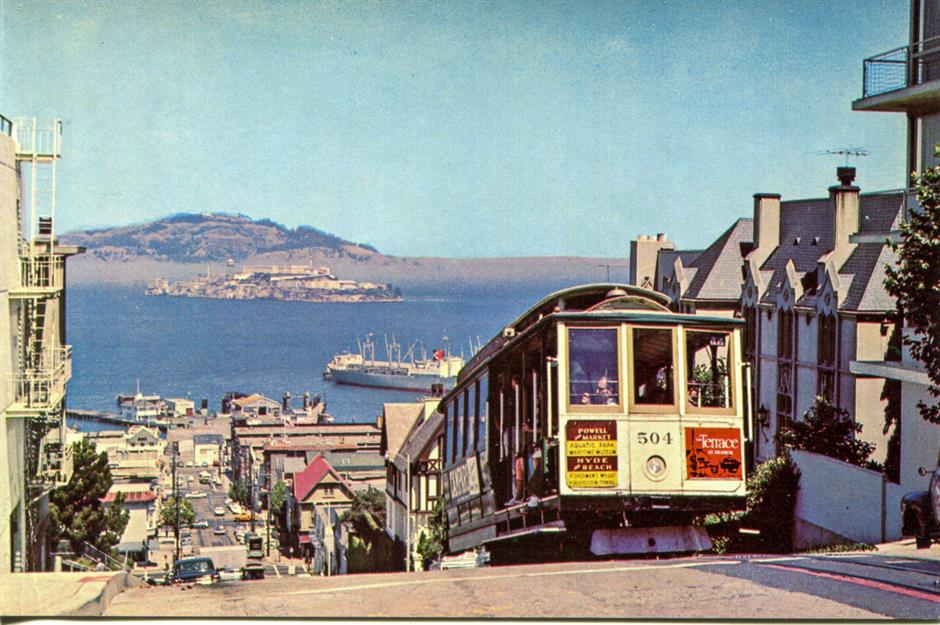
This postcard from 1970 shows people riding a cable car on Hyde Street in San Francisco on a sunny day. This trolley service had come to the city a century before to put an end to the dangerous practice of using horses to pull streetcars up the steep hills.
Note Alcatraz Island in the background. Known as The Rock, it housed a notorious prison until it was closed in 1963.
Colorado: Galena Street, Aspen (1974)
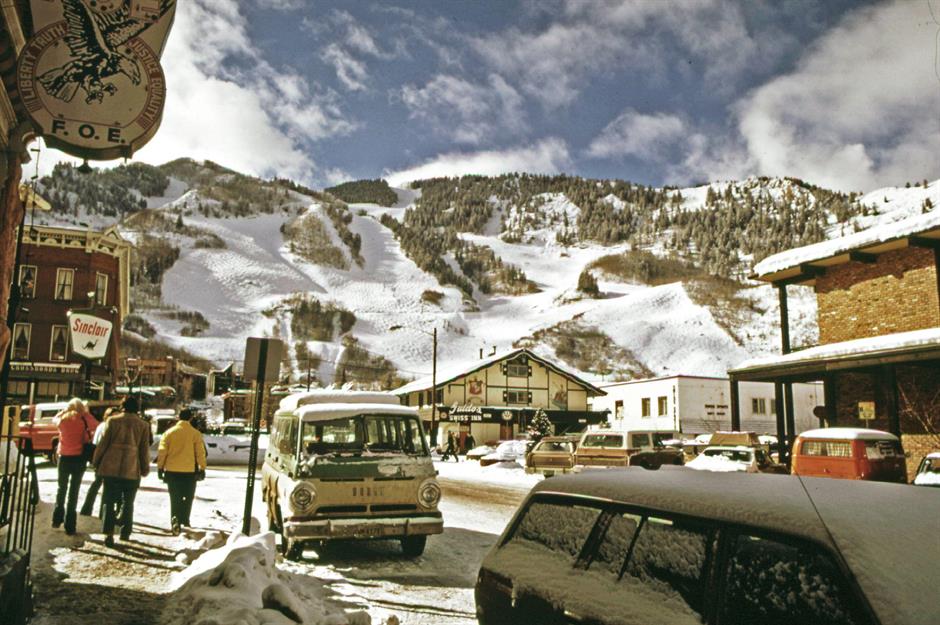
While most of the streets in Aspen are named after early pioneers and investors, Galena Street (pictured) was named after a primary ore found in the surrounding hills, worked for its lead and silver content.
When this photo was taken in 1974, Galena Street was the main thoroughfare to the Ajax Mountain Ski Area. Today, it is home to high-end designer stores like Prada, Valentino, and Zegna, more in keeping with its shiny namesake.
Connecticut: Collin’s Diner, Canaan (1976)
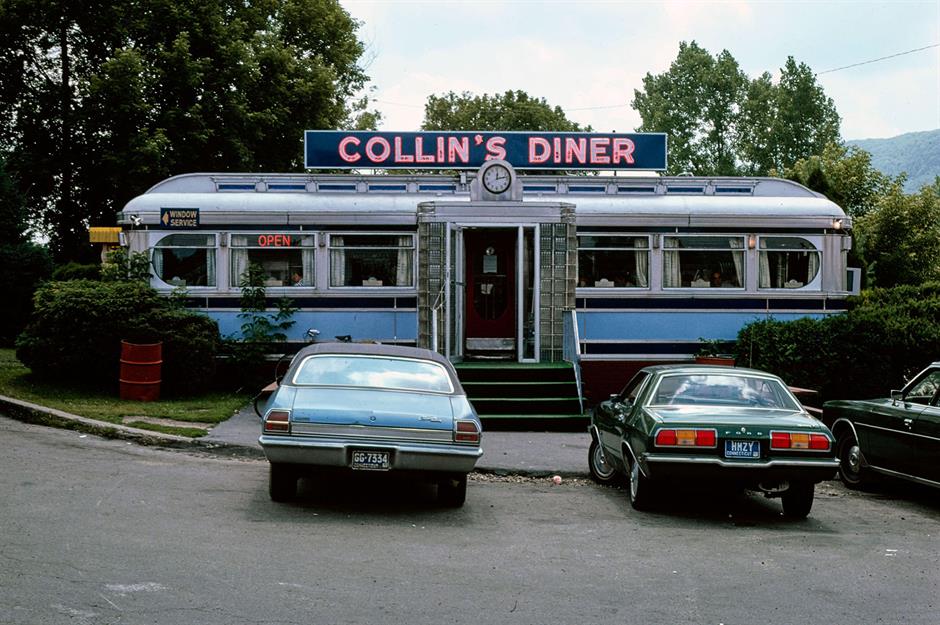
Set off Route 7 on the site of an old railway depot, Collin's Diner has been serving the good people of Canaan in Connecticut – and travelers passing through – for over 80 years.
The diner is a 1941 Jerry O’Mahony Diner, complete with a comforting Art Deco interior and a largely traditional menu. When this photo was taken in 1976, you could also order hummus, tabouleh, and stuffed grape leaves courtesy of the Abo-Hamzy family – migrants from Lebanon – who took over the diner in 1969.
Delaware: Old State House, Dover (1970)
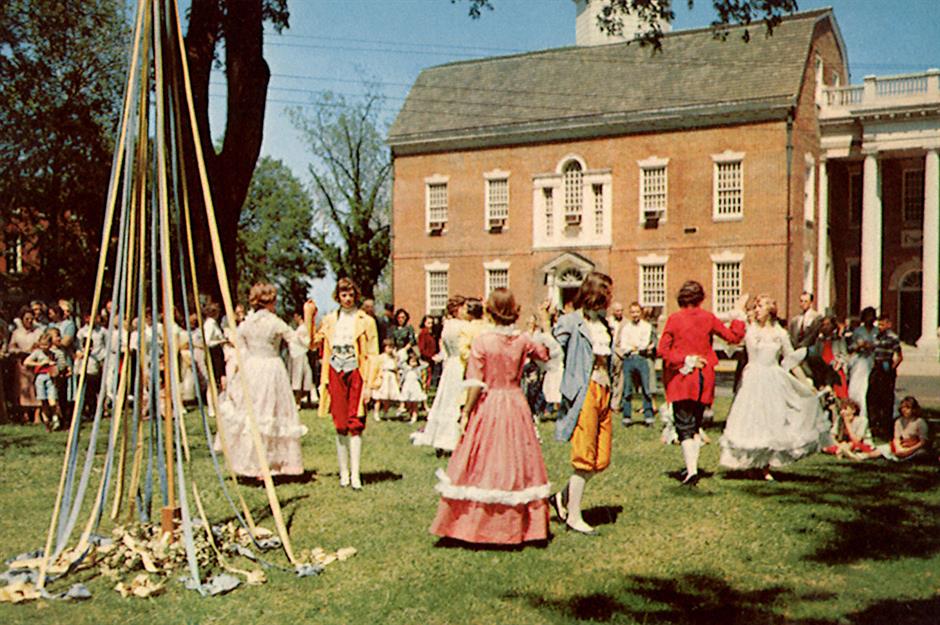
The Old State House in Dover was built in 1791 and served as Delaware’s State Capitol until 1933. The first floor features an 18th century-style courtroom. The second floor is where you’ll find the chambers where the state legislature met.
Regarded as one of the finest Georgian-style buildings in the state, it continued to provide a fitting backdrop to recreations of those times, as seen with these dancers in period costumes, celebrating the coming of spring in 1970.
Florida: Disney’s Magic Kingdom (1970)
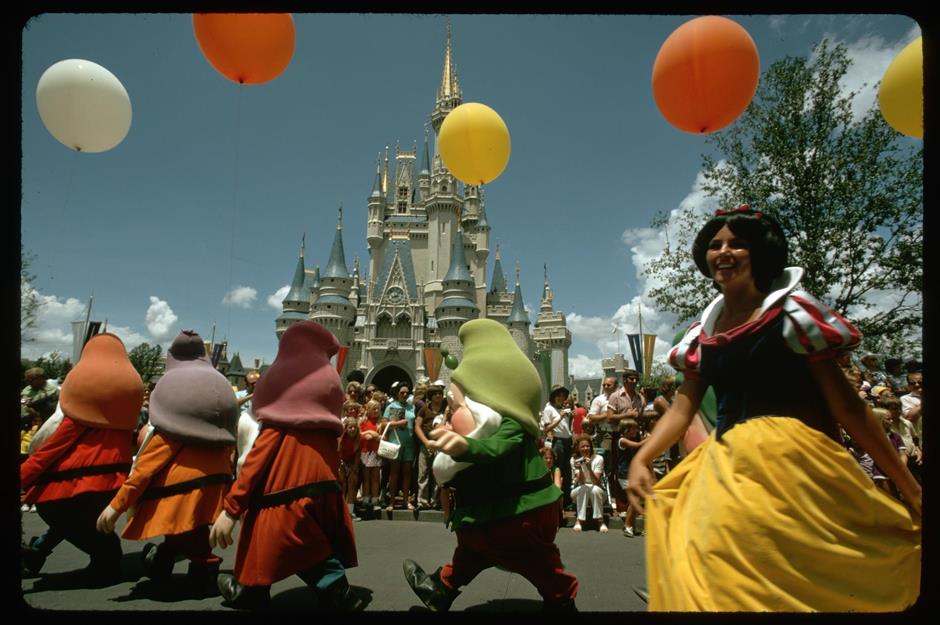
October 1971 saw the opening of the Magic Kingdom, Disney's inaugural Florida theme park, with over 10,000 eager guests descending on the happiest place on earth to experience its magic.
The Magic Kingdom was the first of Disney’s theme parks in Florida, its success kickstarted Orlando’s theme-park boom. Now recognized as the theme park capital of the world, Orlando welcomed 74 million visitors in 2023 alone.
Georgia: Farmer ploughing field in Helen (1970)
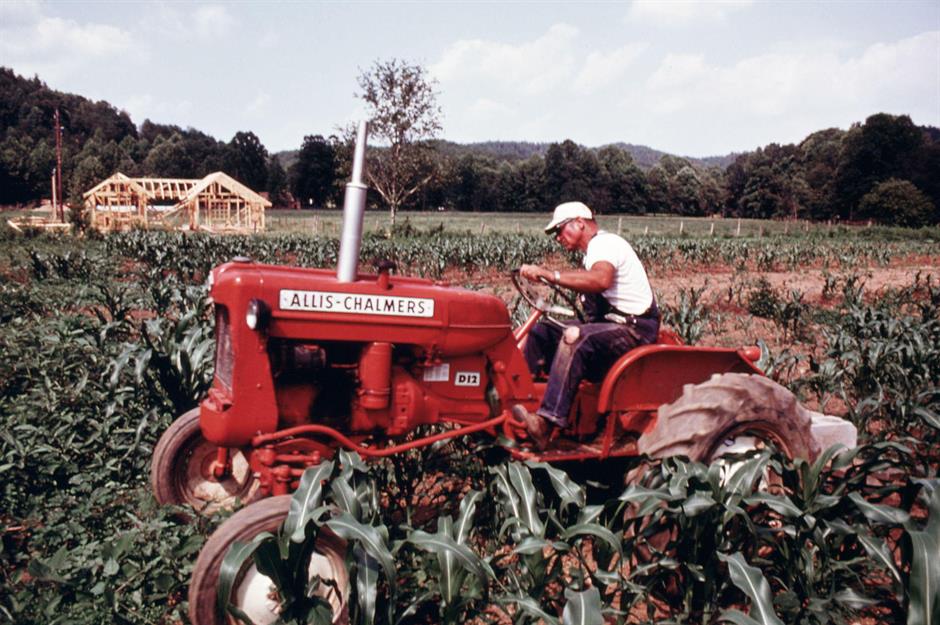
Here we see Al Reinshagen, a local mathematics teacher, farming a strip of land edging Highway 17/75 in Helen, Georgia.
The land in this part of Georgia is particularly fertile and making use of every inch of land was not uncommon. The owner of the plot was happy to let Reinshagen plant corn here rather than let the land go unused.
Hawaii: The Brady Bunch in ‘Hawaii Bound’ (1972)

The Brady Bunch was a feel-good sitcom that followed the trials and tribulations of a resolutely wholesome blended family. While it never troubled the ratings charts during its initial run, it became a huge hit in syndication and a cultural touchstone for young people around the world.
In an attempt to boost ratings, the show’s fourth season, aired in 1972, saw the family vacation in Hawaii, showcasing the islands’ many charms.
Idaho: Camping on Lake Stanley (c.1970s)
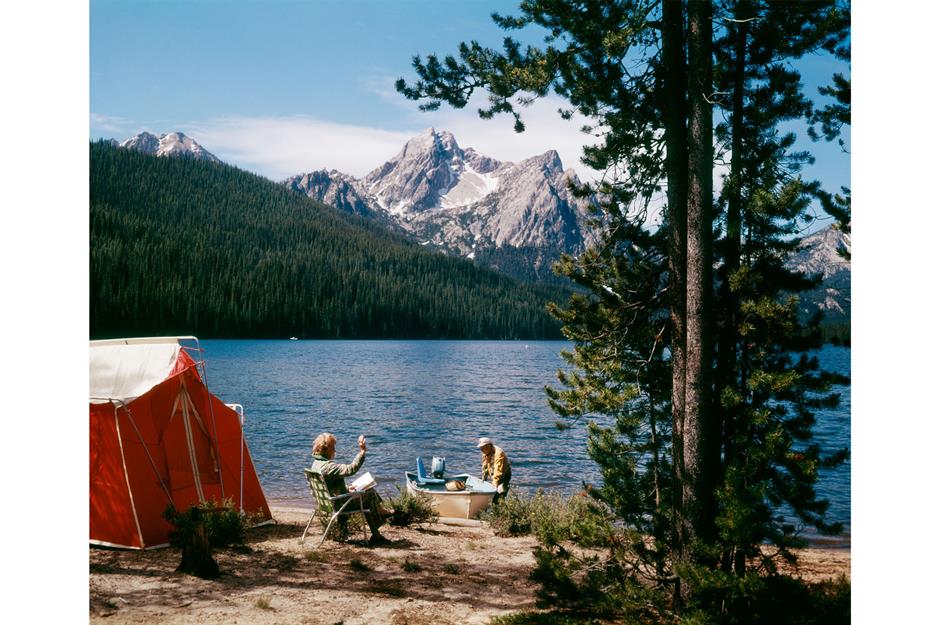
Stanley Lake is a gorgeous alpine lake in Custer County, Idaho. It sits at the base of the stunning Sawtooth Mountains, majestically reflected in its still clear waters, a popular spot for fishing, kayaking, and other water-based activities.
Here we see a couple camping beside its shores, shortly after the Congress established the Sawtooth National Recreation Area in 1972 to protect this recreational wonderland for both locals and visitors alike.
Illinois: Roller Disco fashion show, Chicago (1979)
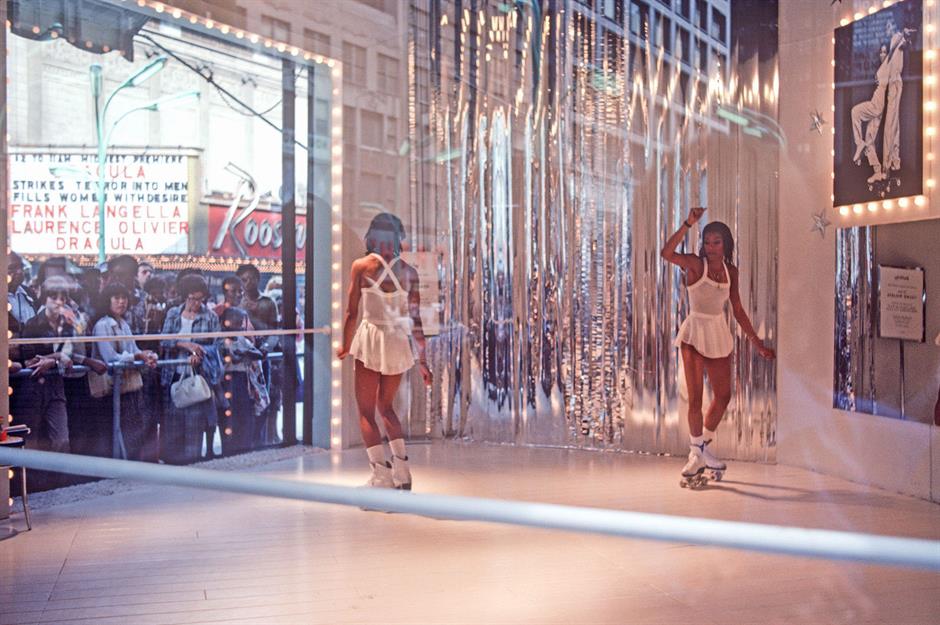
Is there anything more seventies than the roller disco? It merged two of the decade’s biggest obsessions – disco music and roller skating – into an energetic, free-spirited activity that combined music, fashion, and fun.
This certifiable cultural phenomenon touched all aspects of life in the 1970s. Here we see crowds jostling to watch a roller disco fashion show in a department store in Chicago in 1979.
Indiana: Indianapolis 500 (1973)
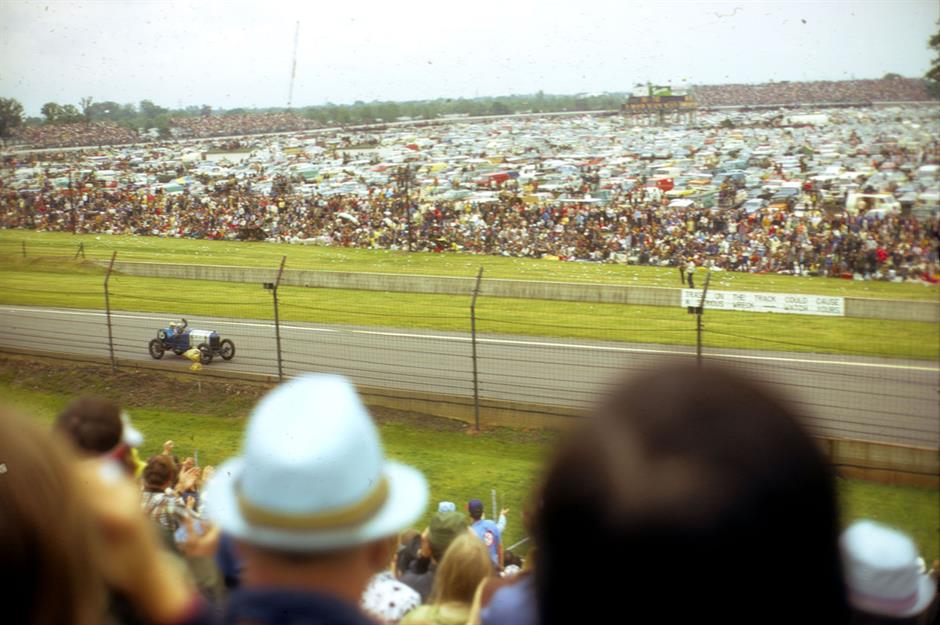
The Indianapolis 500 automobile race has been held annually at the Indianapolis Motor Speedway since 1911. It is regarded as one of the world’s great motor races, attracting the top drivers from all of motorsport’s disciplines.
The 1970s saw the prestige of the race reach dizzying new heights, with the total purse topping $1 million for the first time. Here we see the 1973 Indy 500, a race so blighted by dreadful weather and a series of serious accidents, that it was called to a halt after only 332.5 miles.
Iowa: Sergeant John F. Baker Jr. Bridge, Davenport (1972)
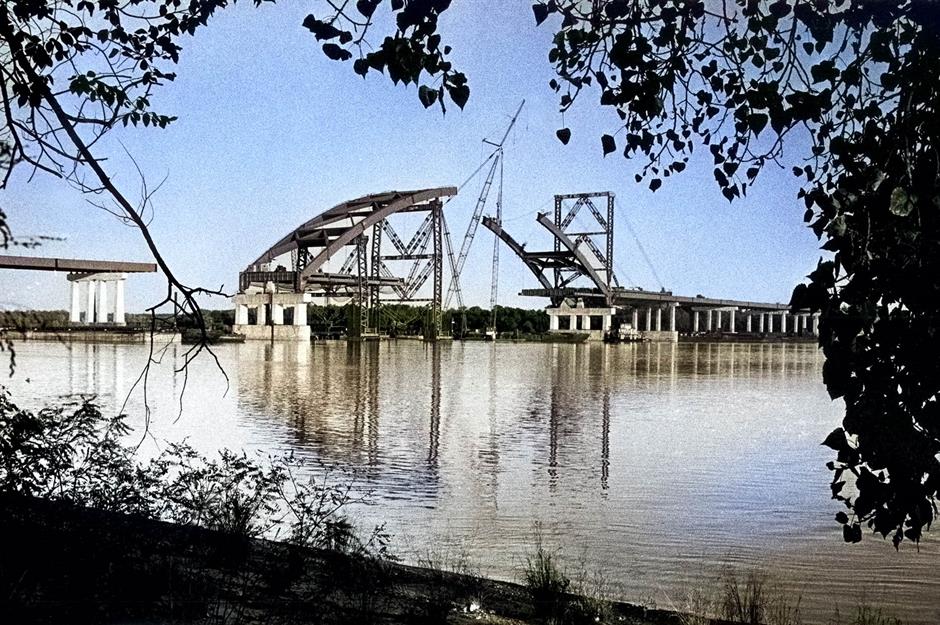
The Sergeant John F. Baker Jr. Bridge spans the Mississippi River near Credit Island in Davenport, Iowa and was built to link the Illinois section of Interstate 280 with its Iowa section. Its large tied-steel arch was famously painted yellow and blue on completion in 1973.
Here we see the bridge under construction in October 1972. Only months before, two workers fell to their deaths, resulting in a measly $360 fine for Busch and Latta Co, the construction company.
Kansas: Grain elevator, White Cloud (1974)
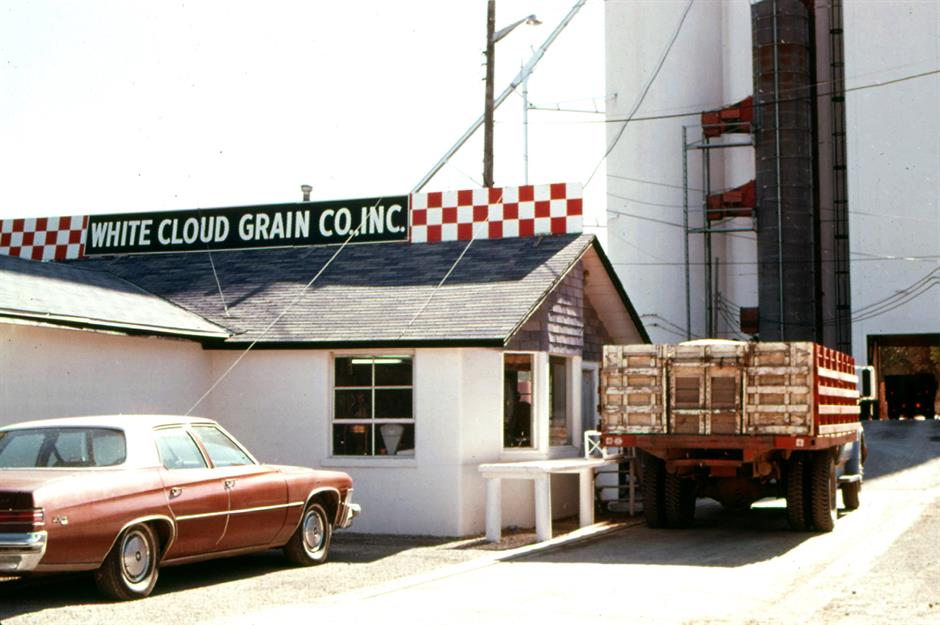
When this photo was taken in 1974, the tall grain elevator belonging to the White Cloud Grain Company in Troy was something of a landmark in this vast empty corner of northeast Kansas. It was also the major employer in the economically-deprived town.
The elevator sat at the edge of the Sac and Fox Indian Reservation, on land given to White Cloud, the last Great Chief of the Iowa Native Americans, after whom the company took its name.
Kentucky: Miners’ homes, Brookside (1974)
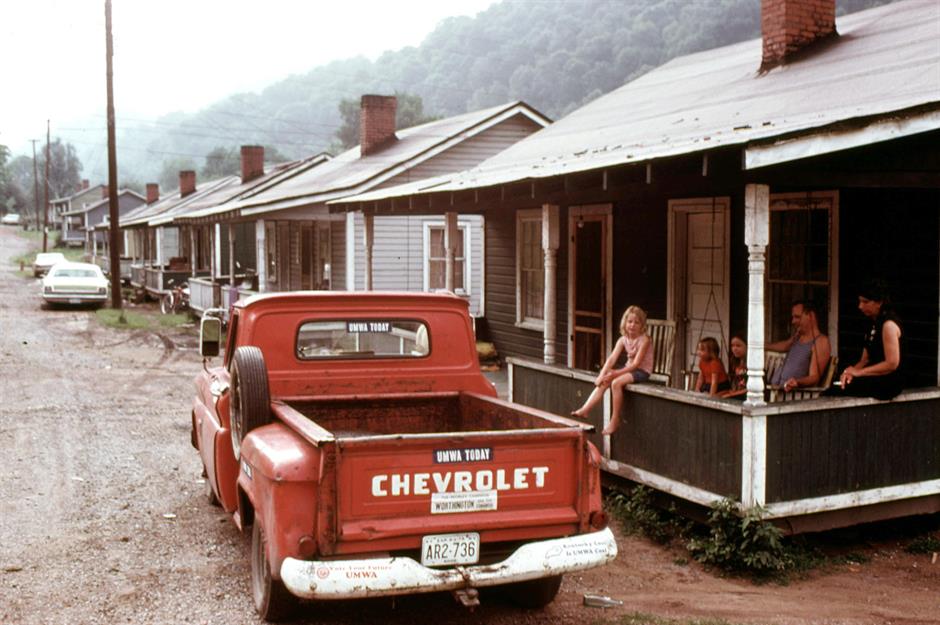
While the 1970s were a period of great innovation and prosperity for much of America, there were corners of the country where very little had changed. Here we see the basic homes of miners in Brookside in Kentucky, owned by the mining company and rented back to its workers. None had running water.
This photo was taken in 1974. A year earlier the camp had been the scene of violent skirmishes, strikes, and boycotts after the miners tried to unionize. The impact of the 13-month-long strike was documented in the harrowing documentary, Harlan County, USA.
Louisiana: Bourbon Street, New Orleans (1976)
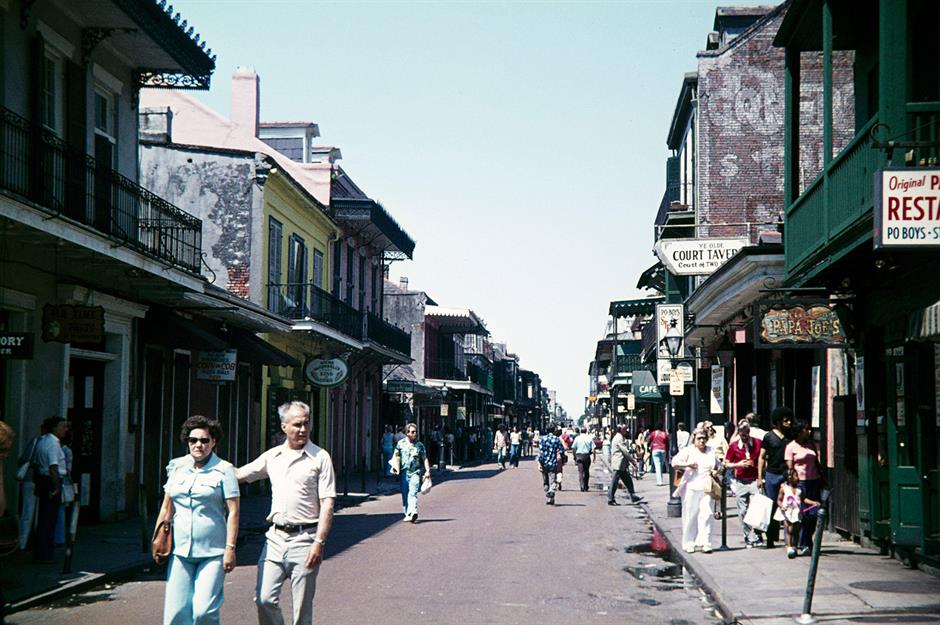
New Orleans’ historic Bourbon Street has always been lively – a cacophonous collection of bars, clubs, and eateries that draw tourists from all over the world. But in the late 1960s and early 1970s it was also synonymous with vice and crime, prompting the city fathers to do something about it.
Led by District Attorney Jim Garrison and Mayor 'Moon' Landrieu a campaign was launched to clean up Bourbon Street and boost tourism. By the time this photo was taken, tourism surpassed the Port of New Orleans as the city’s most profitable industry.
Maine: Fishing in Cape Elizabeth (1971)
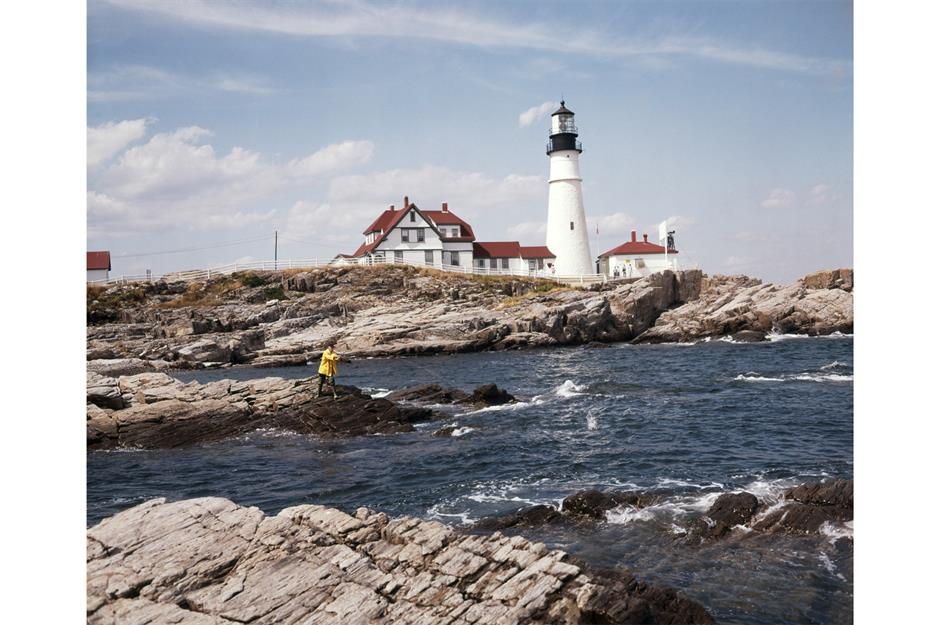
A man fishes in a rock pool in front of the Portland Head Light in Cape Elizabeth, Maine, in a scene that has been played out countless times since it was built in 1791.
Note, however, the group of four people gathered in front of one of the whitewashed outbuildings. In 1971, when this photo was taken, the Cape Elizabeth Town Council approved Fort Williams for use as a scientific research center for a consortium of Maine colleges universities.
Maryland: School excursion to Baltimore harbor (1973)
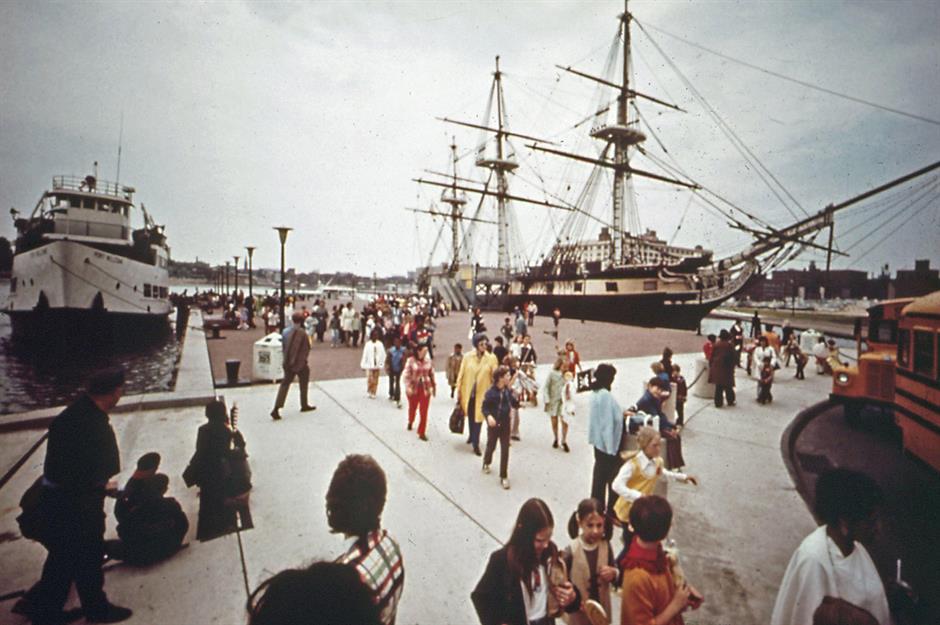
The early 1970s saw Baltimore’s inner harbor undergo a massive facelift, culminating in a City Fair full of colorful carnival rides to celebrate the occasion.
As part of the harbor’s regeneration, a number of historic ships dropped anchor to celebrate the city’s naval and maritime history. Here we see a group of school children in 1973 visiting the USS Constitution, a sloop-of-war built in 1854.
Massachusetts: Haymarket Square, Boston (1973)
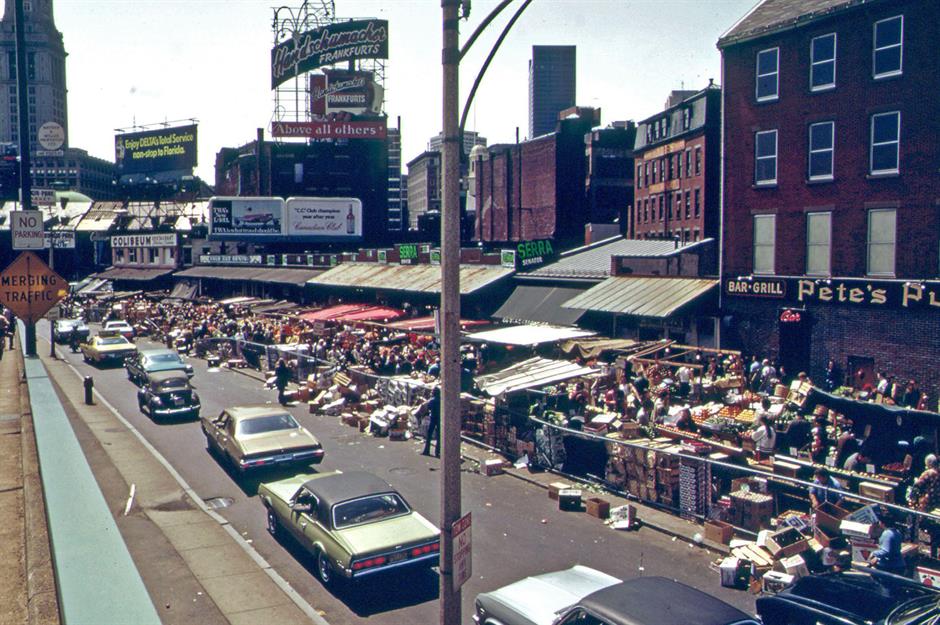
Boston’s Haymarket is the oldest open-air market in America and the city’s go-to place for the fresh and cheapest produce. The vendors have been peddling fruit and vegetables here for nearly 300 years.
Here we see the outdoor food market spilling out onto the streets in May 1973, shortly after plans to knock down the market to make way for an expressway were abandoned after massive protests.
Michigan: Annual smelt run, Tawas City (1973)
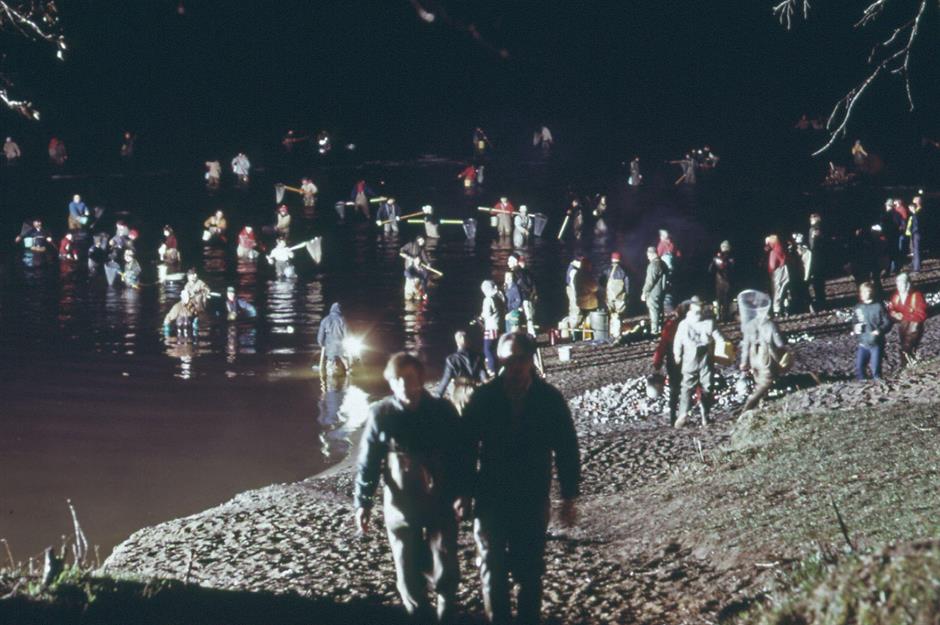
Smelt are small silver fish first introduced into Crystal Lake in northwest Michigan as a food source for salmon. They quickly spread to Lake Michigan and other Great Lakes, and each year they have locals reaching for their waders and nets as they move into tributaries to spawn.
The smelt run usually begins in early spring. Here we see fishing folk gathering at Whitney Drain in April 1973. This man-made canal on Lake Huron near Tawas continues to be a popular spot to dipnet for these small fish.
Minnesota: SkyRise Terrace, St Paul (1971)
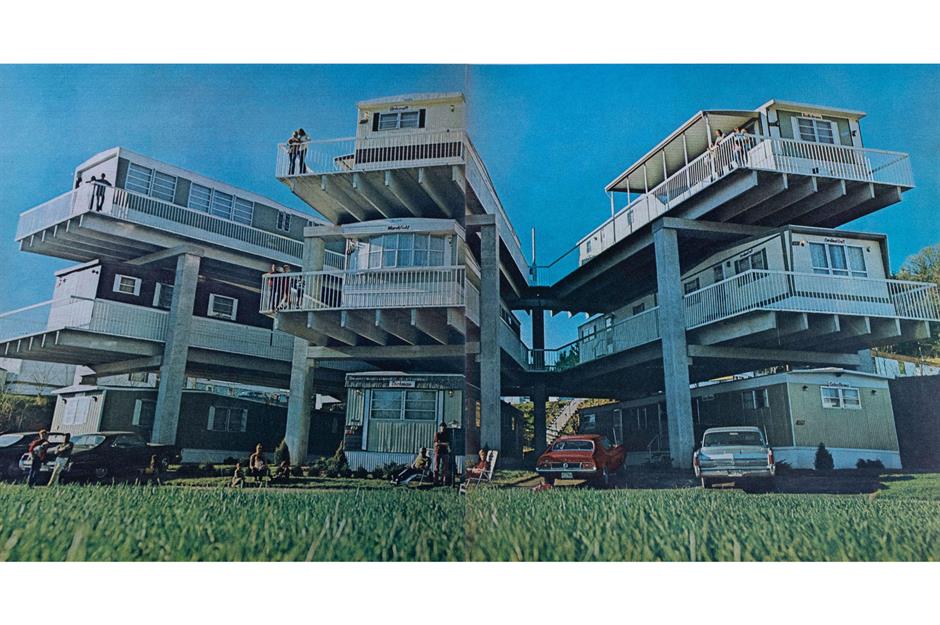
In 1970, Life magazine reported that nearly half of all single-family dwellings sold in America were mobile homes. Americans, they claimed, were attracted by the low cost ($6,000 on average) and ease of maintenance.
Such was the demand, companies like the Mobile Americana Corp were coming up with innovative solutions to living in one in urban areas where land costs were higher. Like the Skyrise Terrace, seen here in St Paul, Minnesota, in 1971.
Mississippi: Hurricane Camille Gift Shop, Gulfport (1979)
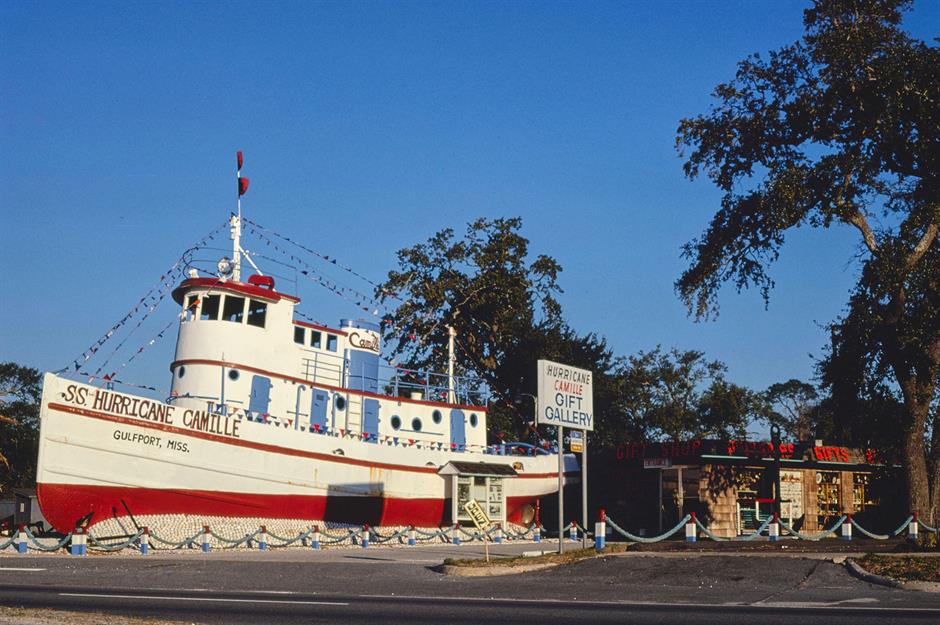
In many ways, the 1970s were the heyday of America’s famous roadside attractions. Towns and tiny settlements across the nation leant into local idiosyncrasies and myths to entice visits to stop and browse the ubiquitous gift shop.
In Gulfport, Mississippi, that was a tugboat washed ashore by Hurricane Camille in 1969. Here we see it 10 years later, securely mounted and turned into a gift shop selling a huge selection of Gulfport and Gulf Coast souvenirs.
Missouri: Tourist information booth, Lake of the Ozarks
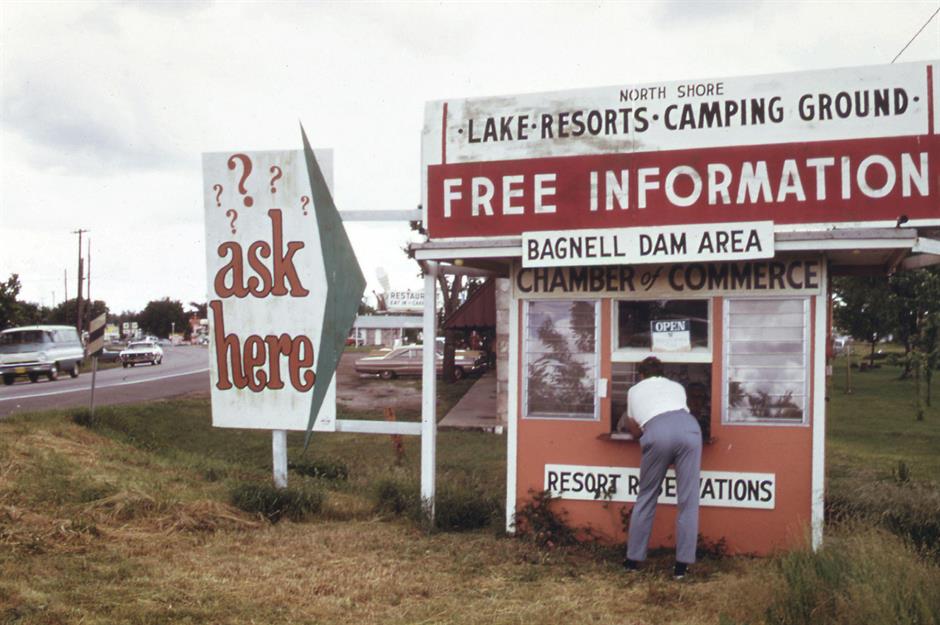
Missouri’s stunning Lake of the Ozarks was created by the construction of the Bagnell Dam in 1931. It was one of the largest manmade lakes in the world, and while the dam was built to produce hydroelectricity, the lake itself became one of the most popular tourist attractions in the Midwest.
Here we see a roadside booth at Eldon, on the fringe of the Lake of the Ozarks region, offering information about the lake’s recreational delights to a southbound traveler in 1973.
Montana: East Glacier Park train station (1974)
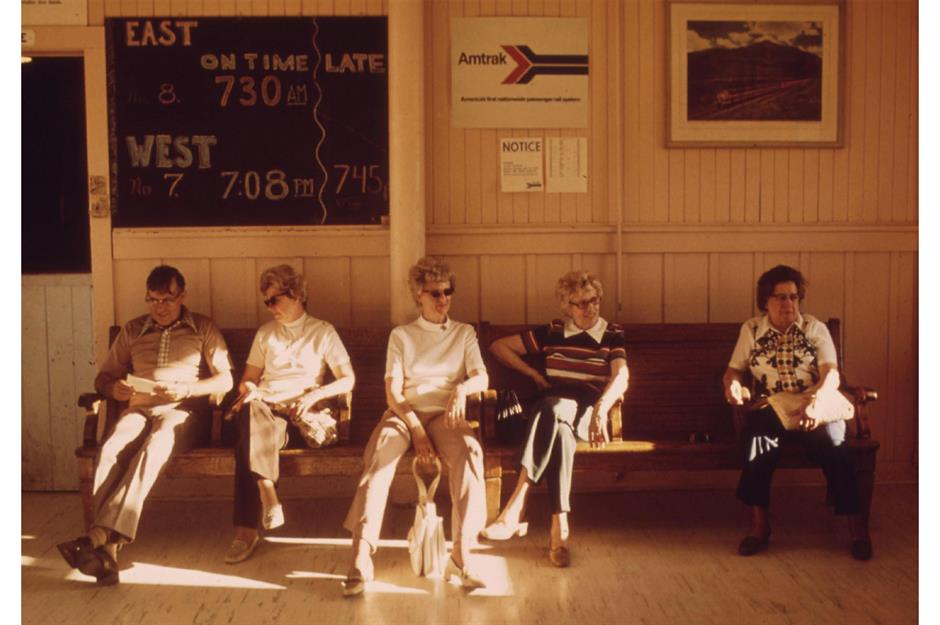
Montana’s Glacier National Park is famous for its epic landscapes, especially the east side where the mountains are higher and the valleys wider. In the 1970s it became more accessible too, with Amtrak assuming responsibility for the intercity rail service that passed through the area.
Here we see passengers at the East Glacier Park station, waiting for the train that will take them back to Seattle. While the schedule in the background lists the eastbound train from Seattle as on time, sadly their train, the westbound Empire Builder, was running late.
Nebraska: Sioux tribal dance, North Platte (1970)
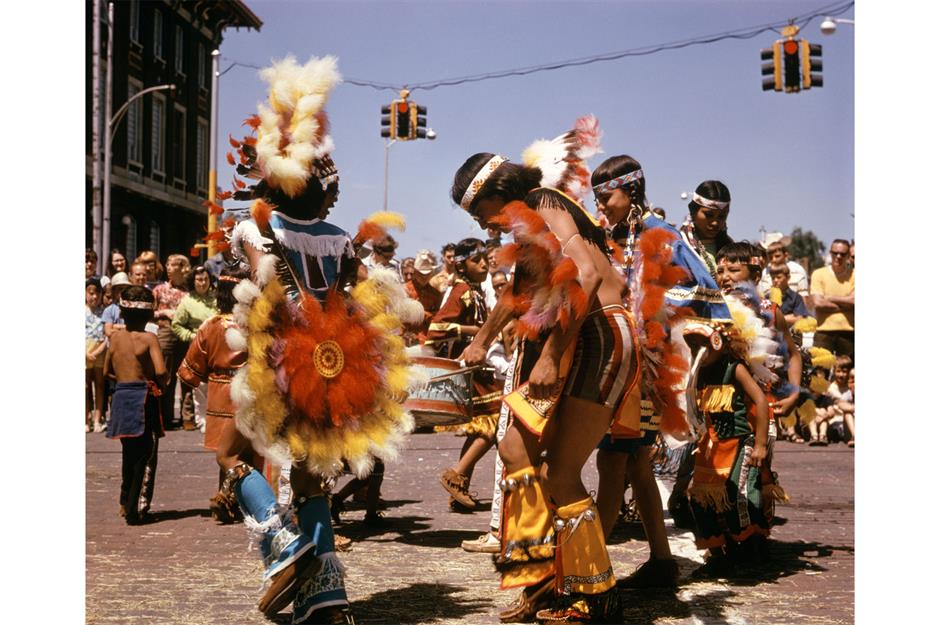
A Pow Wow is a Native American tradition that brings together otherwise disparate tribes and communities. They celebrate and preserve ancient customs through dancing, singing, socializing, crafts, arts, and food.
The North Platte Pow Wow is one of the biggest and oldest in the country, and is still celebrated every July. Here we see a Sioux tribal dance being performed on the main street of North Platte at the 1970 Pow Wow.
Nevada: Fremont Street, Las Vegas (c.1970)
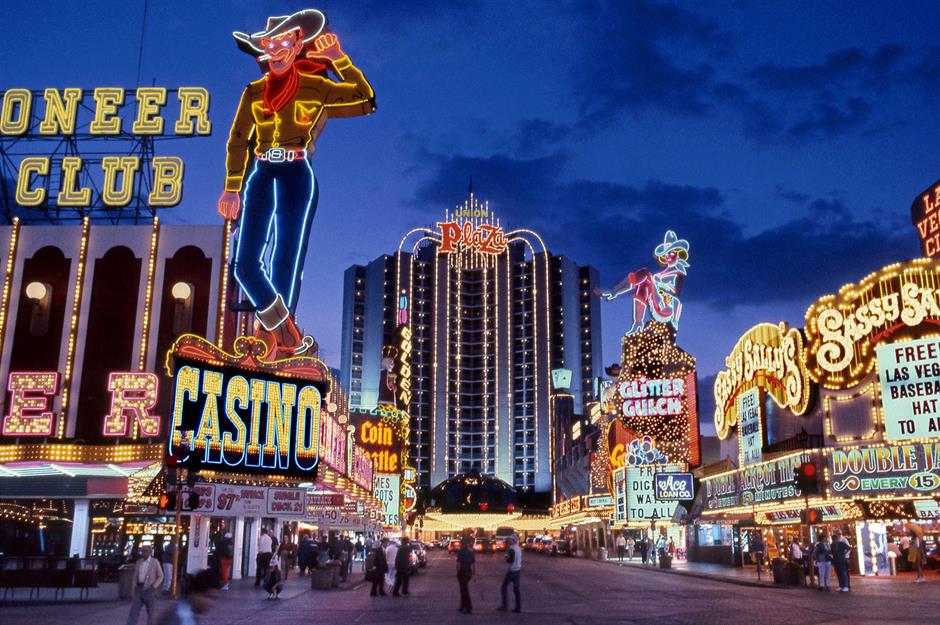
When Thomas Young of Salt Lake City's Young Electric Company passed through Las Vegas in 1933, he convinced the owners of the Boulder Club on Fremont to install one of his company’s new-fangled neon signs. Other business owners quickly followed suit, and the formerly unassuming boulevard became known as Glitter Gulch.
When this photo was taken in the early 1970s, Fremont Street was one of the most photographed in the world, a beacon of blinking lights visible for hundreds of miles into the surrounding desert.
New Hampshire: Waterville Valley (1972)
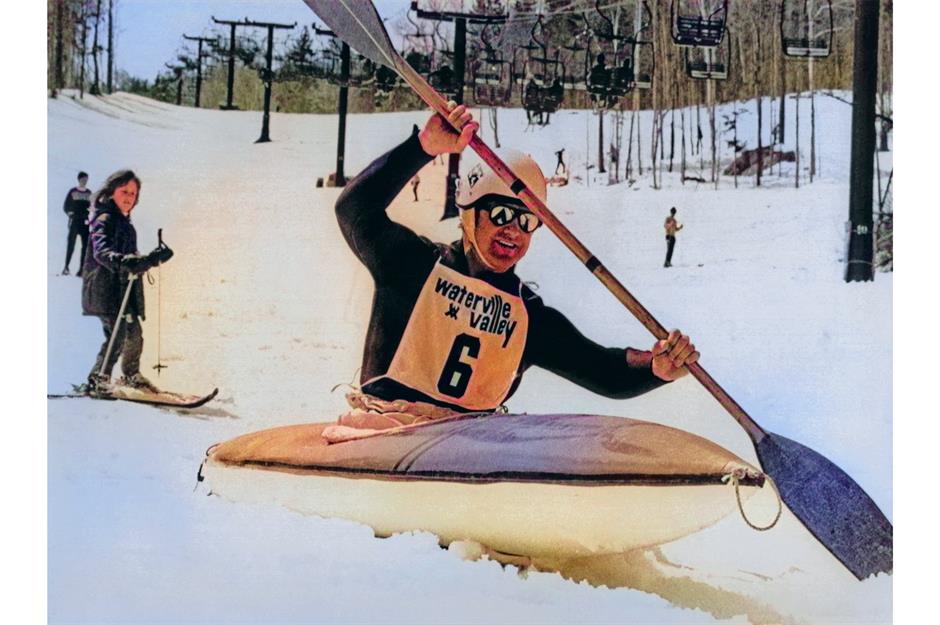
Surrounded by more than 700,000 acres of protected wilderness and nestled deep within New Hampshire’s White Mountains, Waterville Valley Resort has long been a winter playground for winter-sport-loving Bostonians, just two hours from home.
The resort is famous for its pristine ski runs, so skiers were more than a little surprised when this kayaker passed by them on their way down the mountain in April 1972. He was training for the Whitewater Championship on the nearby Mad River later that weekend.
New Jersey: Seaside Heights boardwalk (1978)
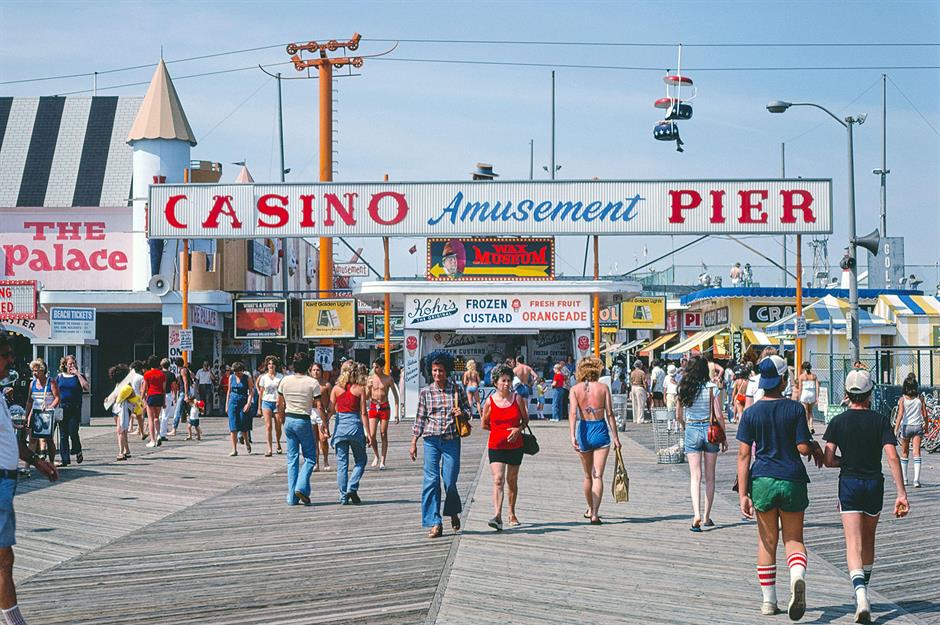
The boardwalk at Seaside Heights on the Jersey Shore opened in 1921 and has been providing sun, fun, and entertainment ever since. Here we see vacationers strolling along the Casino Pier in 1978.
The pier was partially destroyed by Hurricane Sandy in 2012. You might remember the heartbreaking photos of the Casino Pier roller coaster partially submerged in the sea. Thankfully the pier was rebuilt and extended, with a brand-new roller coaster, and continues to thrill and delight visitors to this day.
New Mexico: Mesa viewpoint (c.1970s)
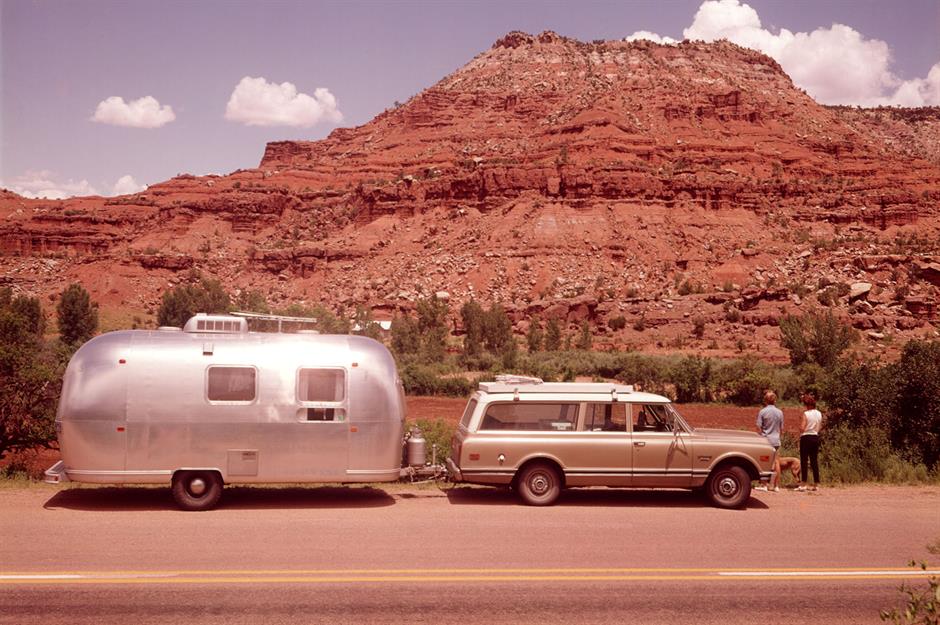
For many Americans, vacationing in the 1970s meant going on a road trip. Entire families – and sometimes pets – were piled into station wagons which were then pointed towards America’s vast network of wide, open roads.
Some, like this couple seen stopped beside a New Mexico highway, had their own trailers. This sleek aluminum trailer would have been more comfortable and luxurious than many of the motels along their route.
New York: Sightseeing cruise, New York City (c.1970s)
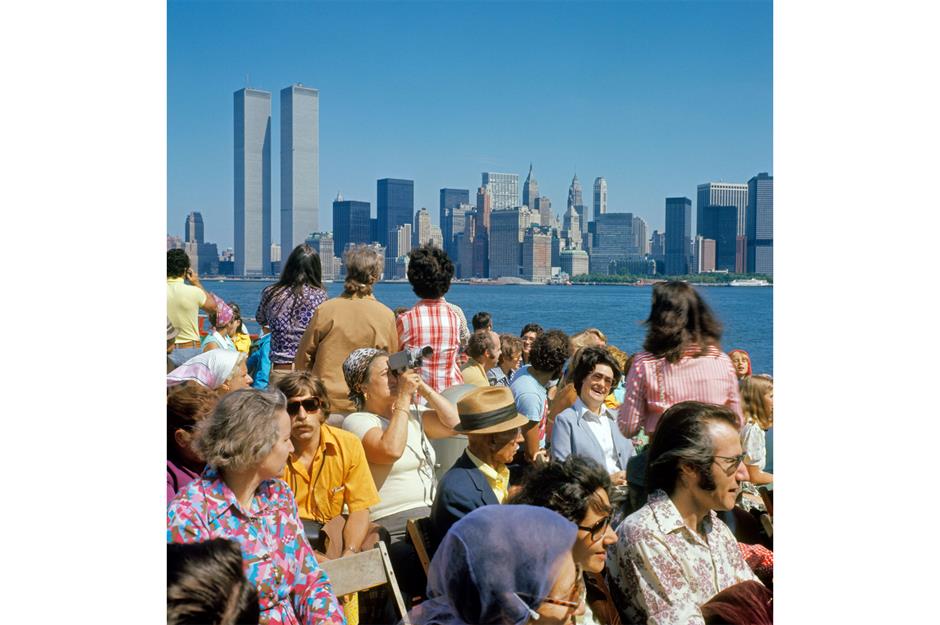
Anyone who lived in New York in the 1970s will tell you that it wasn’t the Big Apple’s finest hour. The city was bankrupt, everything was covered in graffiti, and crime rates were at record highs.
But from the deck of a sightseeing boat, under blue skies, Manhattan still looked magical and inspirational. Especially with the newly constructed World Trade Center towers, optimistically soaring towards the sun.
North Carolina: Prom queen parade, Huntersville (c.1970s)
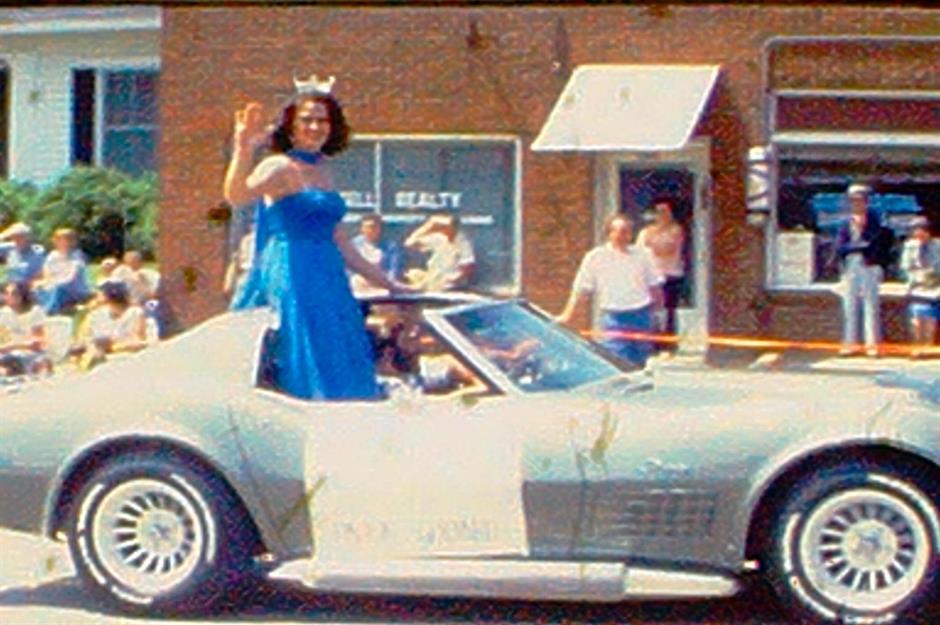
Back in the 1970s, the Prom King and Queen from the local high school were celebrated with a parade through the streets of Huntersville in North Carolina.
The school band and majorettes led the way and were followed by the king and queen, in separate cars, waving to the townsfolk who lined the streets. Open top cars were preferred, allowing the high school royalty to wave to the adoring crowds.
North Dakota: Arriving at Fargo station (c.1972)
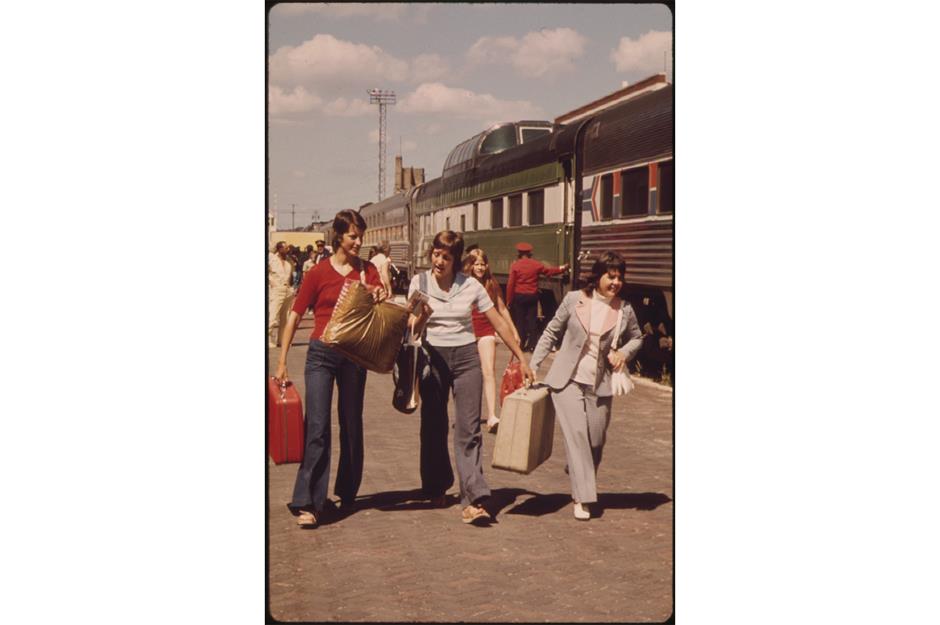
The Empire Builder is a long-distance rail route that operates between Chicago and both Seattle and Portland in the Pacific Northwest. Travelling through bustling cities, mountain ranges, national parks, glaciers, and forests, it is regarded as one of the most scenic rail journeys in North America.
The route was inaugurated by the Great Northern Railway in 1929, but when this photo was taken around 1972, it had been taken over by the newly-formed Amtrak. Here we see passengers disembarking at Fargo, an important stop along the line.
Ohio: Aerial view of Toledo (c.1970s)
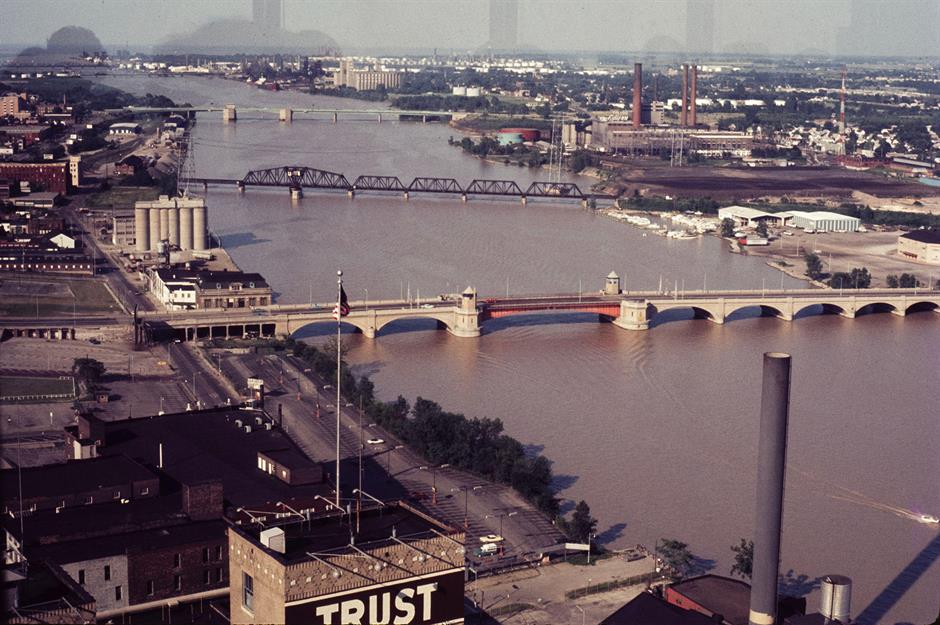
Toledo reached its peak in the 1970s, with a population of 383,818 thriving on the success of its glass industry. Once a swamp, it was seen as a future rival to New York.
However, globalization and deindustrialization took their toll, and by the late 20th century, the city had declined. This 1970s aerial photo captures Toledo at its height, highlighting the Maumee River, iconic bridges, and vast industrial complexes that fueled its prosperity.
Oklahoma: Oral Roberts University, Tulsa (c.1977)
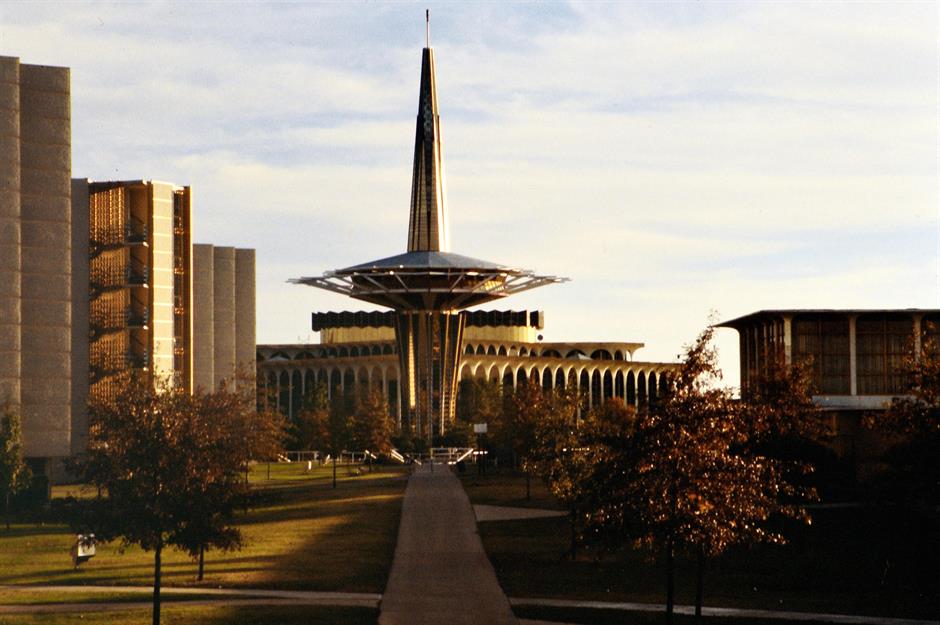
Founded in 1963, this privately owned university in Tulsa is named after its charismatic founder, Christian preacher Oral Roberts. It bills itself as one of the largest, most influential Christian liberal arts universities in the world, but it is equally famous for its futuristic, Art Deco buildings.
Like the 200-foot Prayer Tower, pictured here in 1977. Designed in the shape of a modern-day cross by Tulsa architect Frank Wallace, the building is laden with Christian symbolism. The building’s lattice work, for example, represents the crown of thorns placed on Jesus's head when he was crucified.
Oregon: Union Station, Portland (1974)
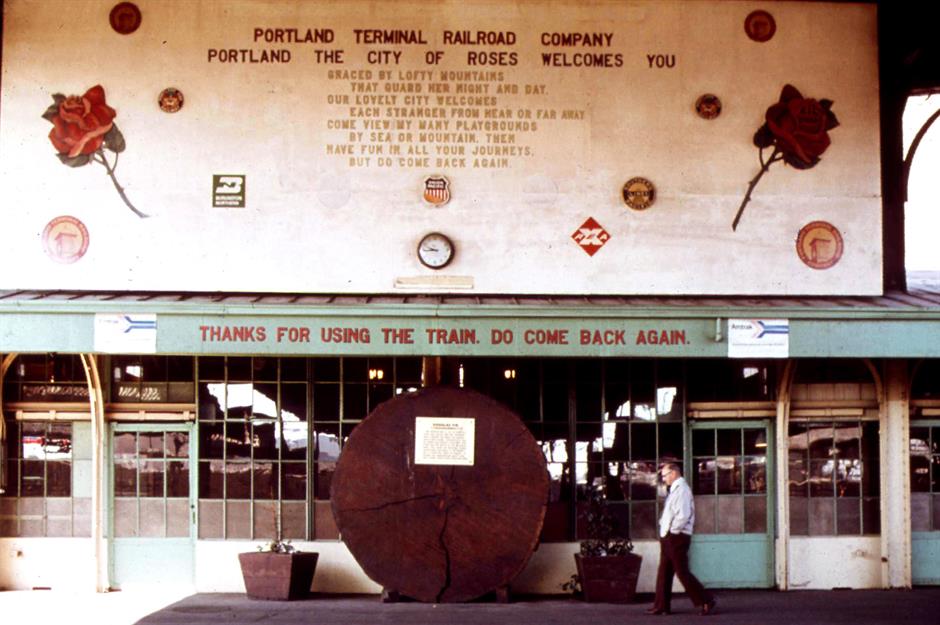
Here we see Portland’s Union Station in July 1974, with a huge sign welcoming passengers to the City of Roses. The nickname stems from Portland’s ideal climate for growing roses and its long-standing tradition in cultivating them.
The poem greeting visitors was equally sweet. The uncredited poet extols the city's ‘lofty mountains’ and ‘many playgrounds’ before imploring visitors to ‘have fun in all your journeys.’ And to come back again, of course.
Pennsylvania: Street parade, Philadelphia (1976)
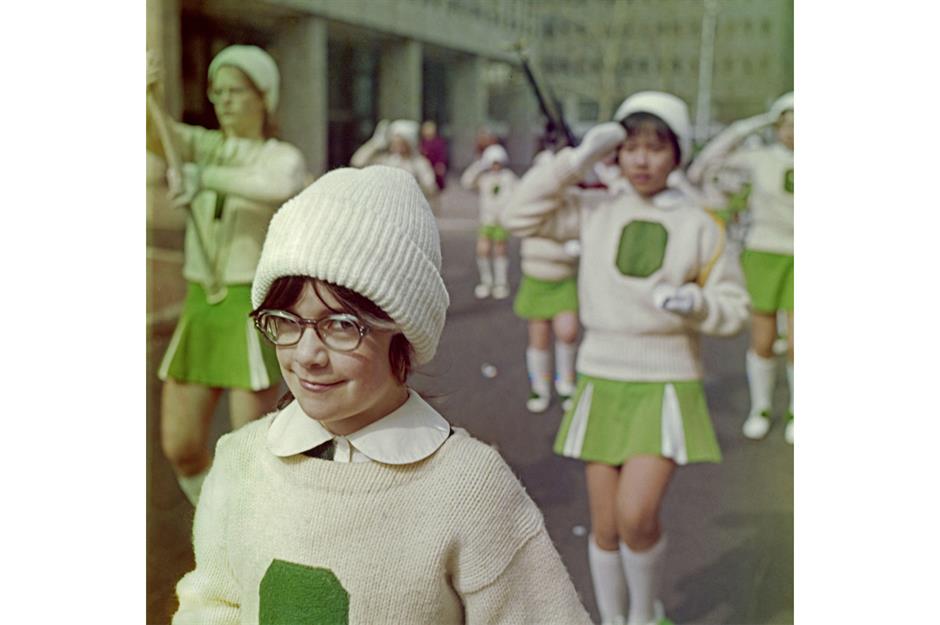
The annual St Patrick's Day parades in New York and Boston may be the best known in the United States, but this annual celebration of all things Irish has actually been observed for the longest time in Philadelphia.
The first St Patrick’s Day parade was held in the Pennsylvanian capital way back in 1771, making it older than the country itself. Here we see participants in the 1976 parade, wearing green, naturally.
Rhode Island: Giant milk can, Lincoln (1978)
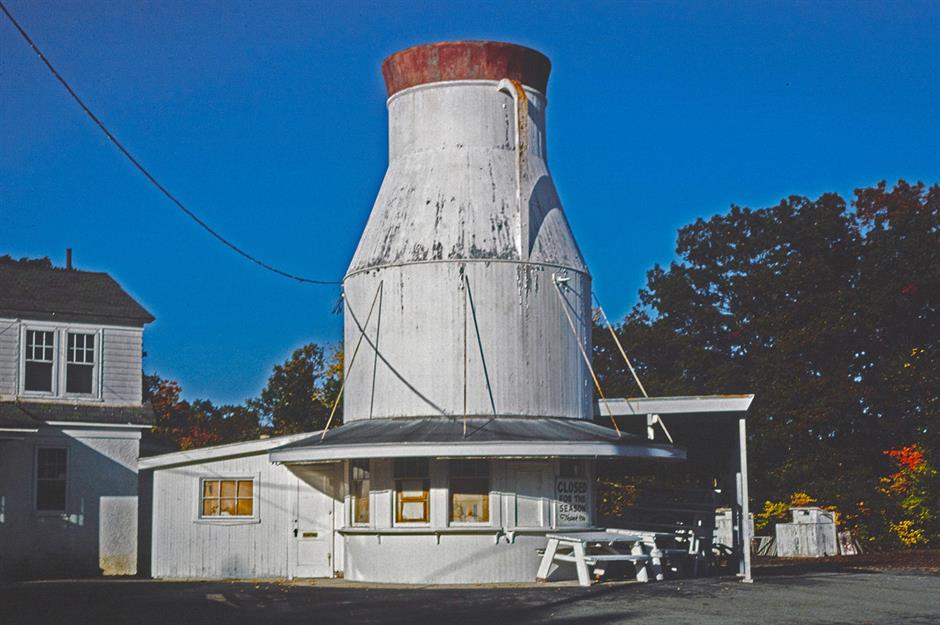
This 32.5 foot-high milk can started its life beside Route 146 in Lincoln as part of an ice cream stand. Its original owner, Charles Plante, hoped that the oversized novelty building would compel passing motorists to stop and sample his wares.
When this photo was taken in 1978, the establishment had been closed for 10 years and plans were underway to demolish it as part of safety improvements along Route 146. Preservationists got it added to the National Register of Historic Places before it was moved to its current location in North Smithfield in 1988.
South Carolina: Jungle Golf, Myrtle Beach (1979)
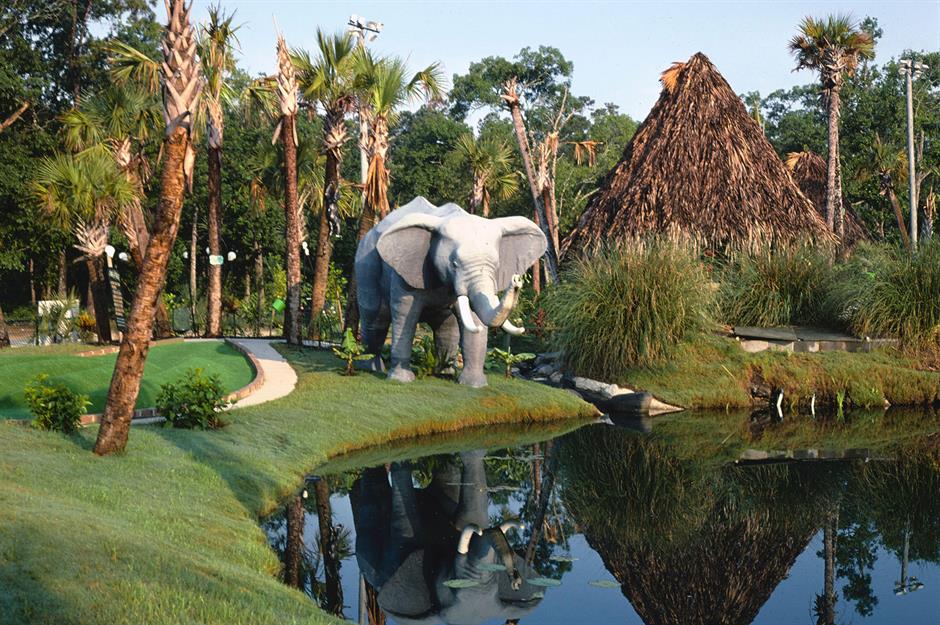
Playing mini golf on often bonkers novelty courses was one of the great joys of vacationing in America in the 1970s. Resort towns across the US jostled with each other to create the most spectacular, most challenging and most memorable putt-putt golfing experiences in the country.
One of the most unforgettable courses was Jungle Golf in Myrtle Beach. Seen here in 1979, the course led players through the ‘wilds’ of South Carolina in their quest to become ‘King of the Jungle’. It’s just one of the reasons Myrtle Beach is regarded as the 'Mini Golf Capital of The World'.
South Dakota: Reptile Gardens Wild Animal Park (1975)
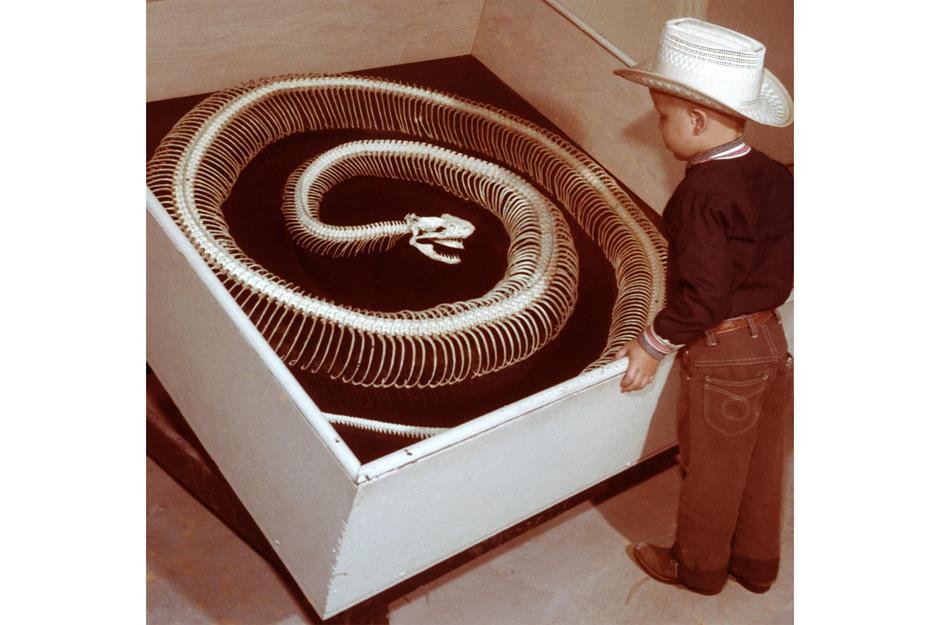
In some ways, the 1970s were a much simpler time. Who needed electronic games and tablets to entertain vacationing youngsters when there were giant snake skeletons to distract them?
Here we see a young visitor wearing a cowboy hat at the Reptile Gardens Wild Animal Park in Rapid City, South Dakota, in 1975. It is still open, albeit with a few more bells and whistles for today’s demanding youth, and is recognized by Guinness World Records as the largest reptile zoo in the world.
Tennessee: Interstate 24 near Nashville (1972)
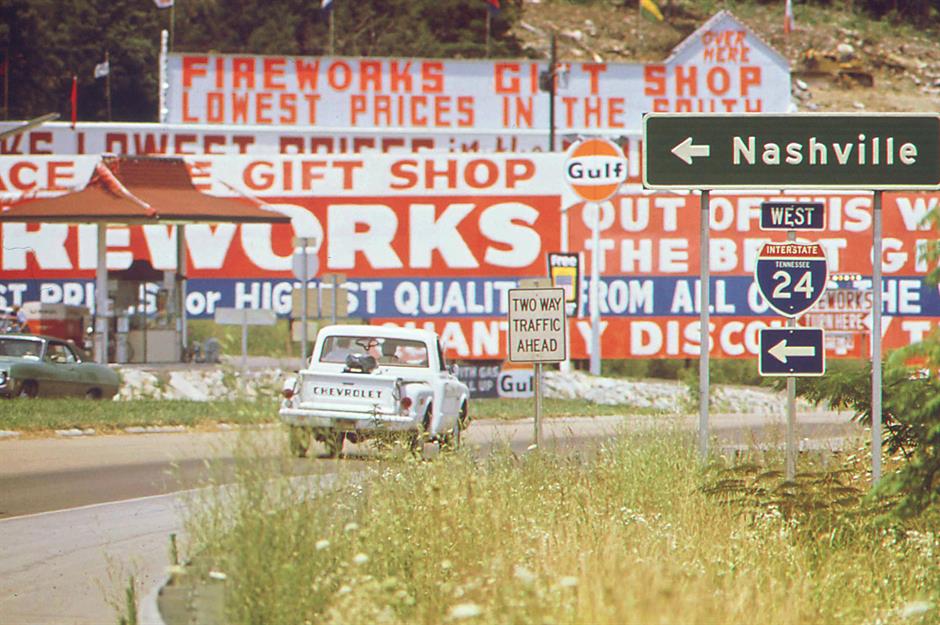
In many US states in the 1970s, the sale of fireworks was heavily regulated, but less so in Tennessee. The more liberal regulations there saw people from Kentucky and Indiana flocking to the state to stock up with celebratory explosives, especially around Independence Day and Memorial Day weekend.
One of the biggest fireworks stores sat on Interstate 24, just east of Nashville. It was hard to miss, as can be seen in this photo taken in 1972.
Texas: Dallas freeway (1970)

The 1970s saw an unprecedented building boom in the Texan city, Dallas. Flush with oil money, downtown quickly became a forest of soaring skyscrapers, conceived by internationally acclaimed architects and designed to impress.
By the 1970s it became apparent that the city’s Central Expressway needed to be modernized and expanded. Here we see some of the new elevated sections of the expressway that were built, providing traffic relief, albeit briefly, to the rapidly expanding city.
Utah: Dead Horse Point, Canyonlands (1972)
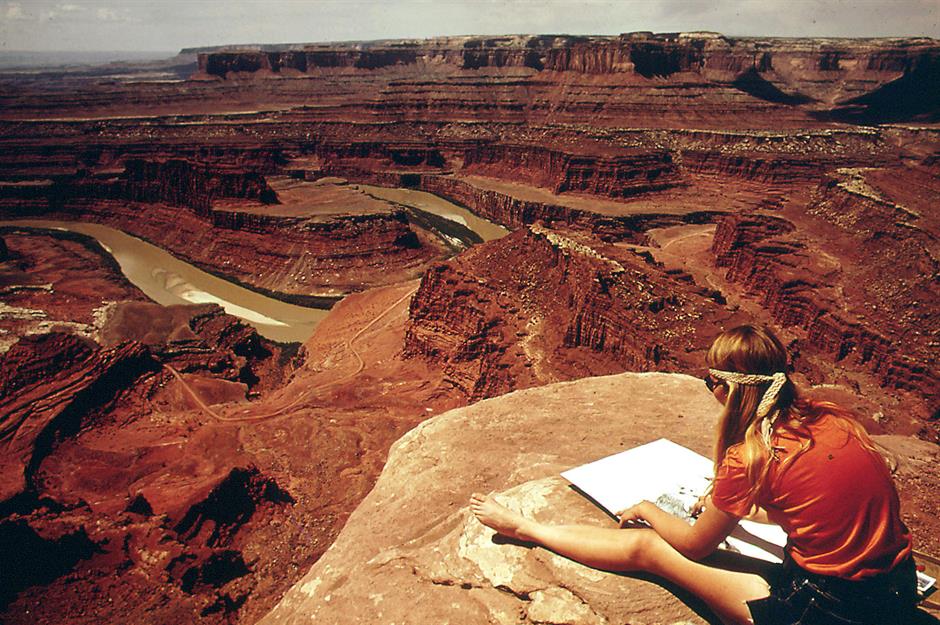
Here we see another photo from the Environmental Protection Agency’s project, DOCUMERICA. The program entailed photographically documenting subjects of environmental concern across the nation, this time in Utah’s stunning Canyonlands.
Taken in May 1972, the photo shows a young environmentalist taking notes from the famous viewing spot overlooking the Colorado River at Dead Horse Point.
Vermont: Farm shop (1975)
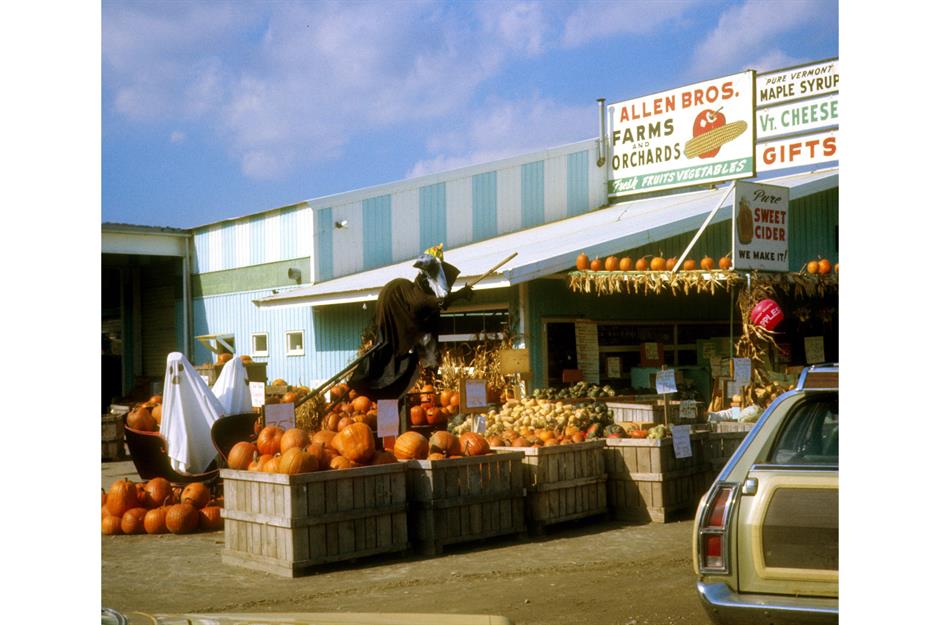
When four brothers purchased an orchard in Westminster back in 1956, they kickstarted a revolution that would be quickly mimicked by farmers across Vermont and then the country. Instead of just growing produce, the Allen brothers also sold it directly to locals and visitors passing by on the I-91.
Here we see their farm shop in October 1975, selling pumpkins for Halloween, as well as their usual range of fresh fruit and vegetables.
Virginia: Tysons Corner Mall, Tysons Corner (1976)
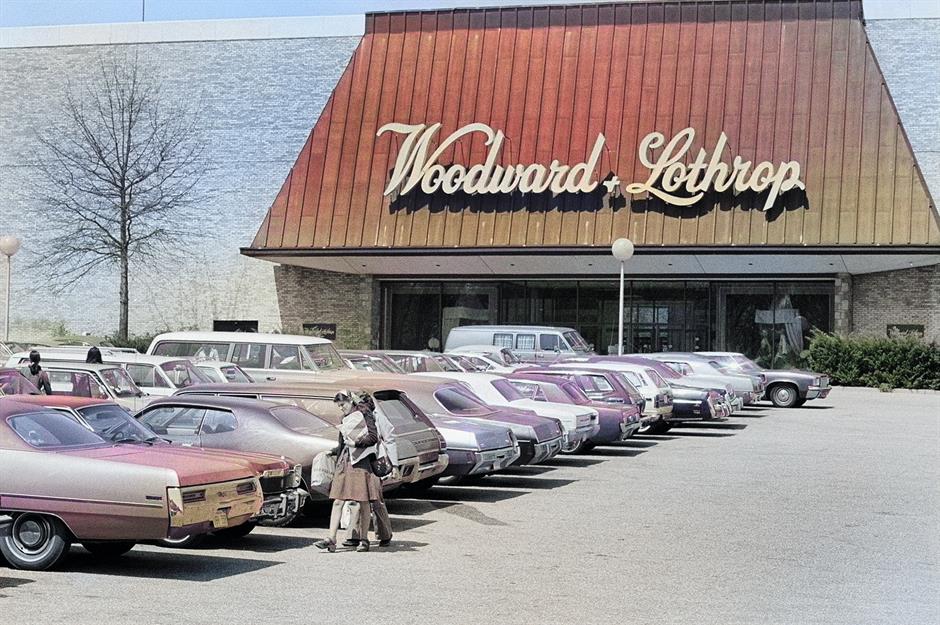
The Tysons Corner Mall in Virginia may have been built in 1968, but it sparked a trend that would be followed by many of the malls built in the 1970s. As well as offering a fully enclosed, climate-controlled shopping experience, it served up a new vision of urban spaces in the USA.
Here we see shoppers parking outside in 1976, eager to enter a new type of mall that mimicked the outdoor environment with trees, gardens, and water features.
Washington: Seattle skyline (1973)
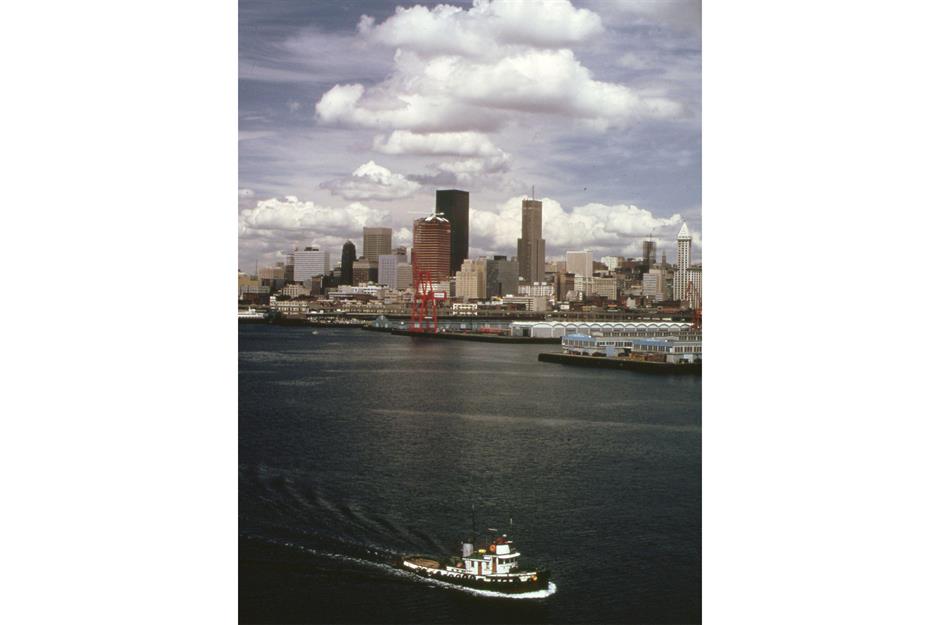
When this photo was taken in 1973 Seattle had a population of only 1.6 million people. The city skyline, seen here from Puget Sound, was equally diminutive.
The city’s distinctive skyscrapers like Columbia Center (1985), 1201 Third Avenue (1988), and Two Union Square (1989), were still a decade or so away, let alone the Rainier Square Tower, which wasn’t built until 2021.
West Virginia: Laundromat, Cedar Grove (1973)
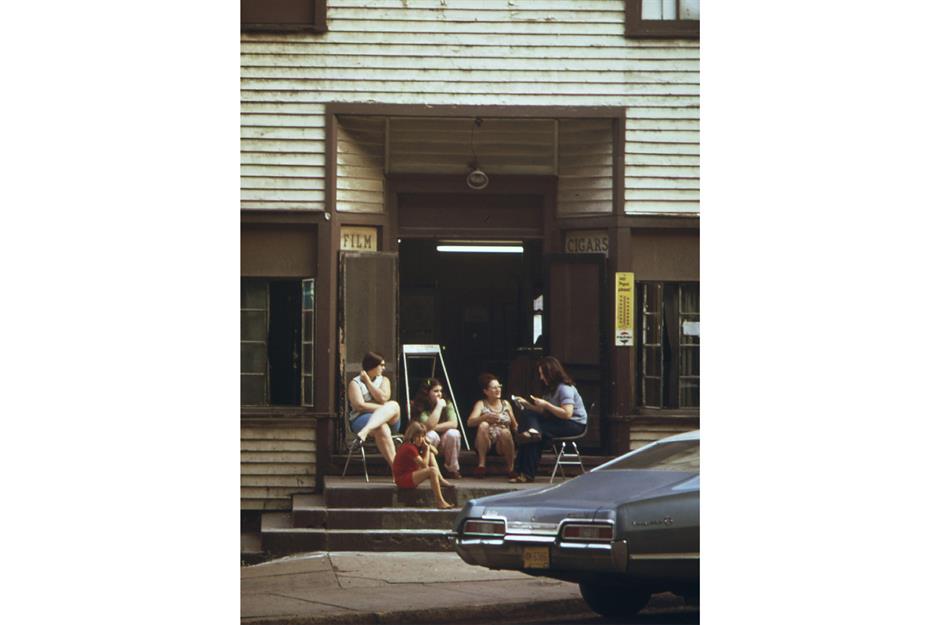
If you ask people what they miss most about the 1970s, chances are they’ll say that it is the sense of community. Things just seemed altogether more neighborly.
Like this scene captured on the steps of a laundromat in Cedar Grove, West Virginia in 1973. Germans were amongst the earliest settlers in the state and the ladies seem to be partaking in a kaffeeklatsch, when friends gather for coffee and gossip.
Wisconsin: Lake Mendota (1979)
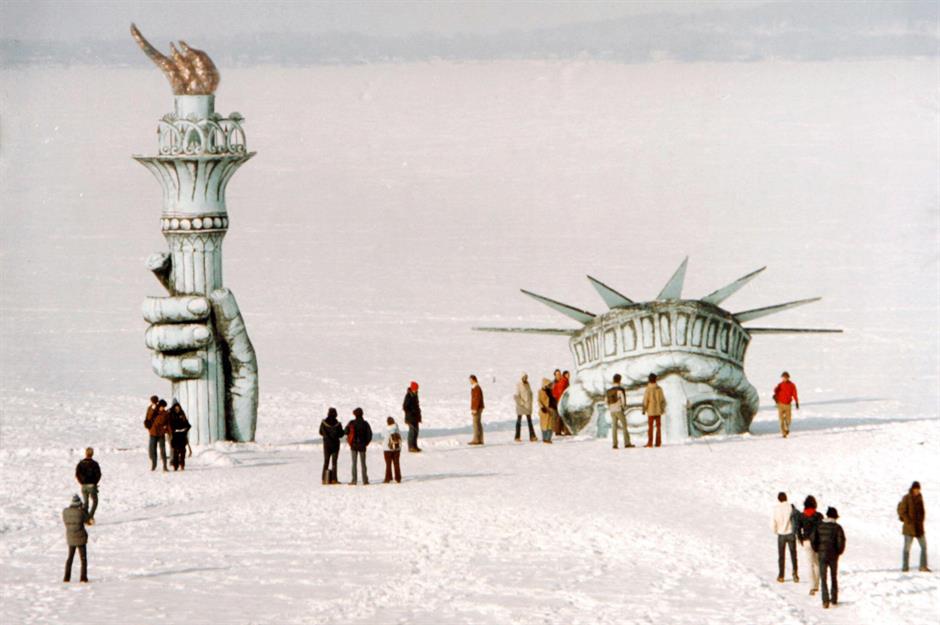
There was a certain playfulness to the 1970s too, as seen here in an astonishing public art stunt on the ice of Lake Mendota in Madison, Wisconsin in February 1979. Created by Leon Varjian and Jim Mallon, it garnered national attention.
‘Lady Liberty’, as she was known, was the fulfilment of a promise Varjian and Mallon had made if they were elected to the University of Wisconsin-Madison student association. They spent $4,000 of their own money to create it. That’s $17,500 in today’s money.
Wyoming: Rodeo Fair, Cheyenne (c.1970s)
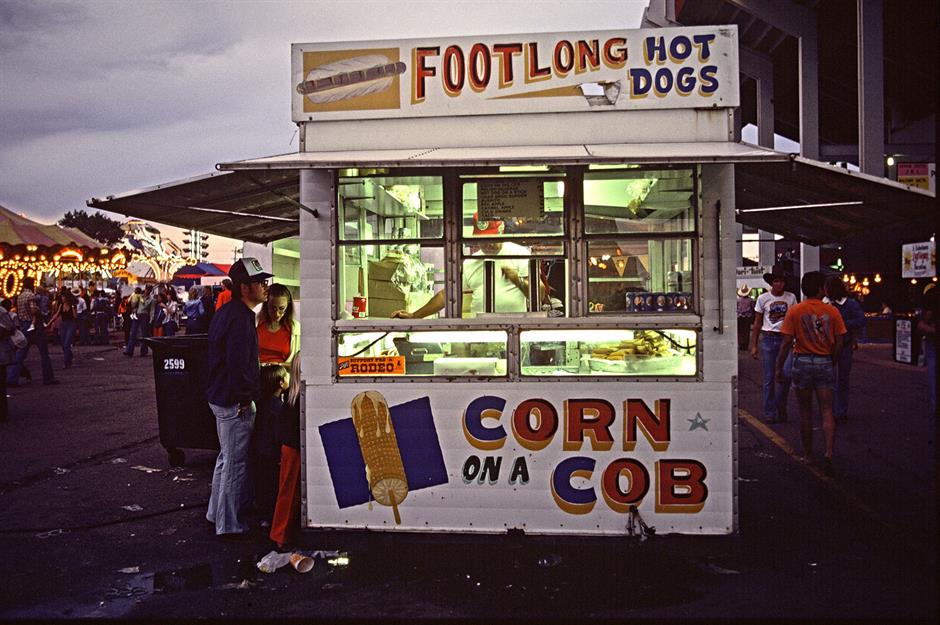
Cheyenne’s Frontier Days is the world's largest outdoor rodeo and western celebration. Cowboys have been bronco busting, steer roping, and pony racing here every July since 1897.
There’s a Grand Parade, plenty of midway rides and all the fun of the fair, of course. The gathering is famous for its free pancake breakfasts, served every morning to ticket holders. But just like in this photo taken in the 1970s, sometimes nothing quite hits the spot like a footlong hot dog.
Comments
Be the first to comment
Do you want to comment on this article? You need to be signed in for this feature